AD 227 Exam 1 Key Works & Study Guide
1/144
There's no tags or description
Looks like no tags are added yet.
Name | Mastery | Learn | Test | Matching | Spaced |
|---|
No study sessions yet.
145 Terms
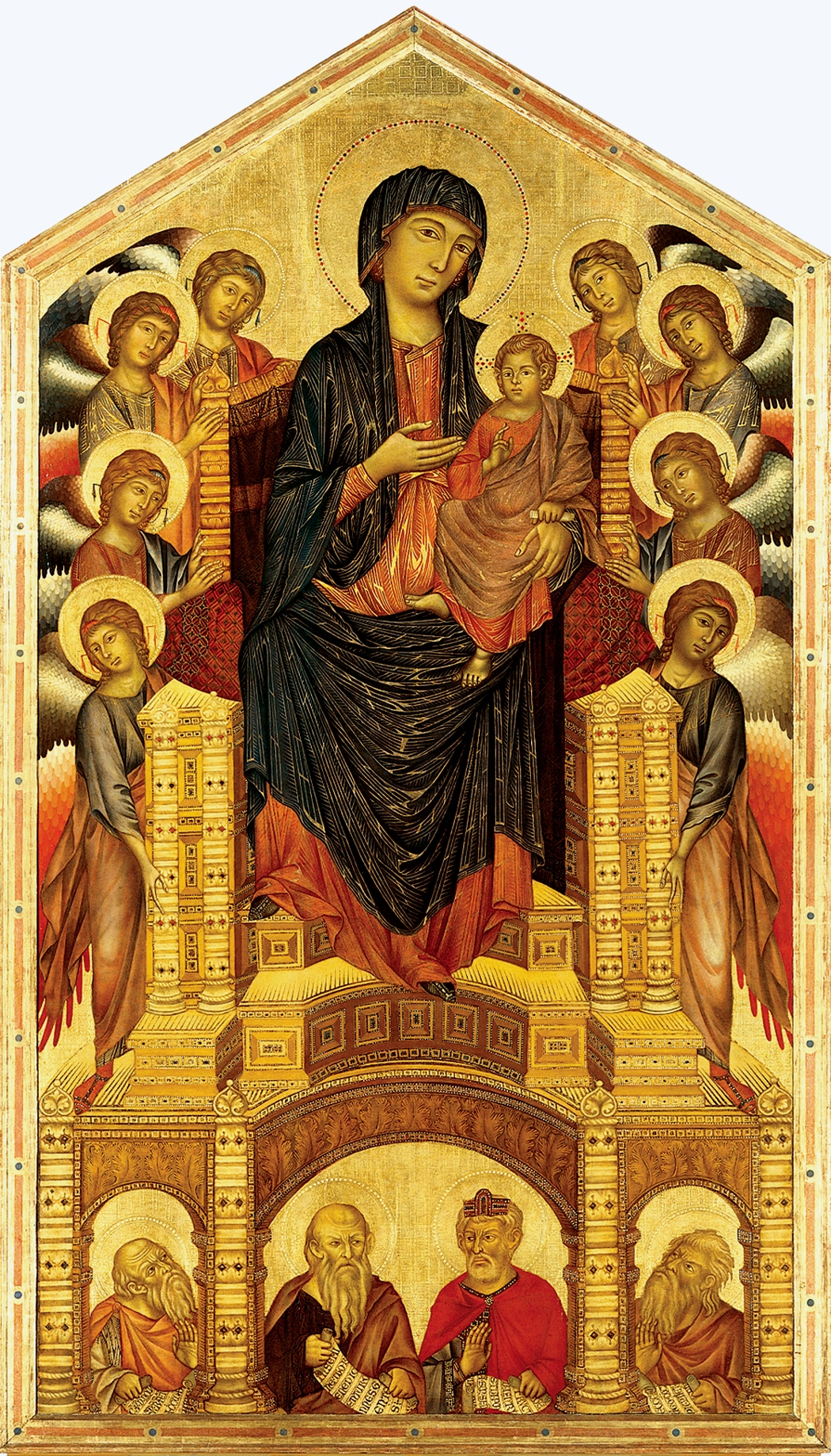
Cimabue, Madonna Enthroned with Angels and Prophets.
Santa Trinità, Florence, ca. 1280–1290.
Tempera and gold leaf on wood.
Departure from Italo-Byzantine styling with enhanced depth, three-dimensionality (see drapery).
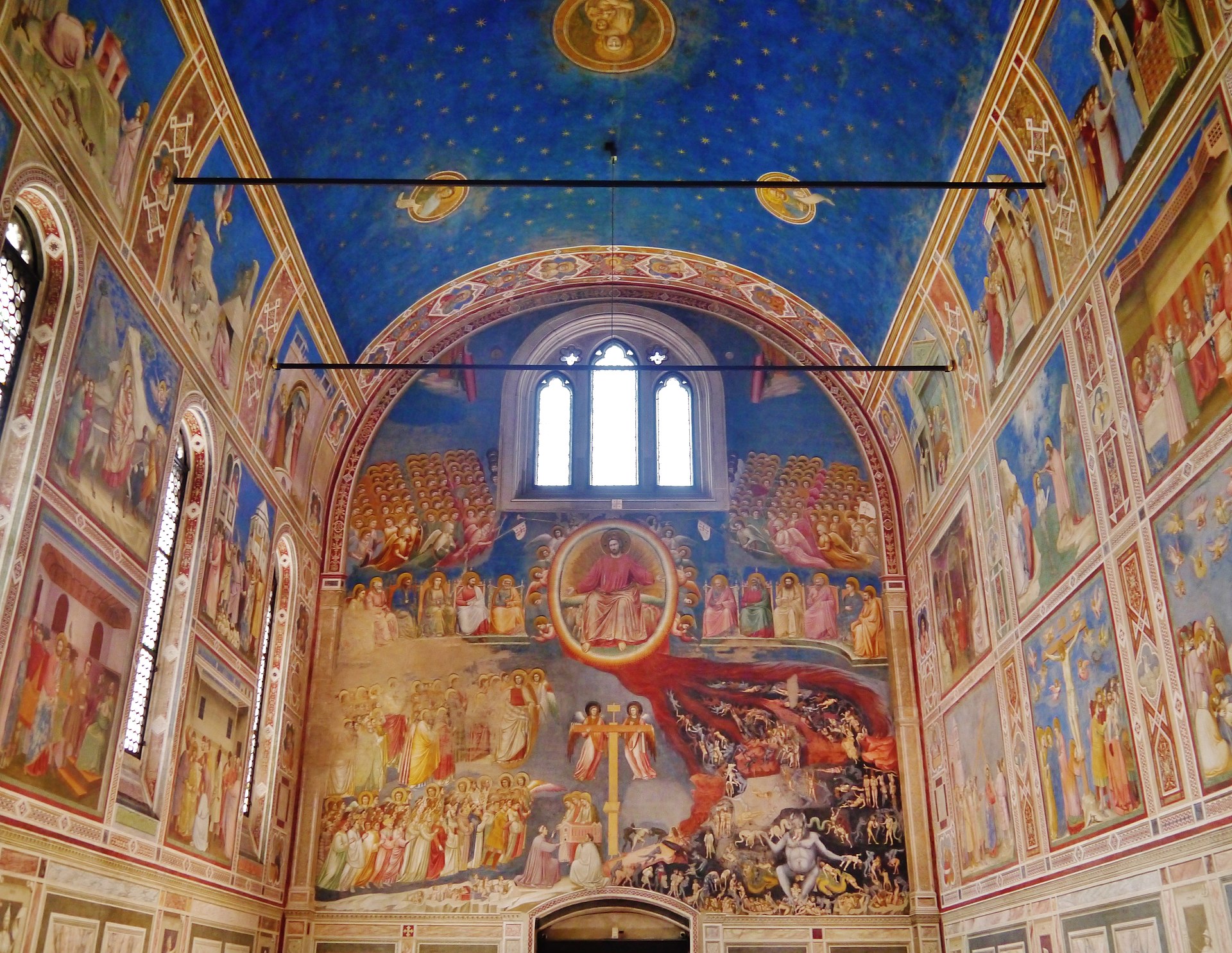
Giotto, interior of the Arena Chapel (Cappella Scrovegni).
Padua, Italy, 1305–1306.
Fresco.
Commissioned by Enrico Scrovengi as atonement for family sin of usery. Transitioning from focus of symbolism to realism.

Duccio, Virgin and Child Enthroned with Saints, principal panel of the Maestà altarpiece.
Siena Cathedral, Siena, Italy, 1308–1311.
Tempera and gold leaf on wood.
Commission celebrating Sienese victory over Florentines, paraded through city upon completion. Continues trend of realism and three-dimensionality developing around this time.
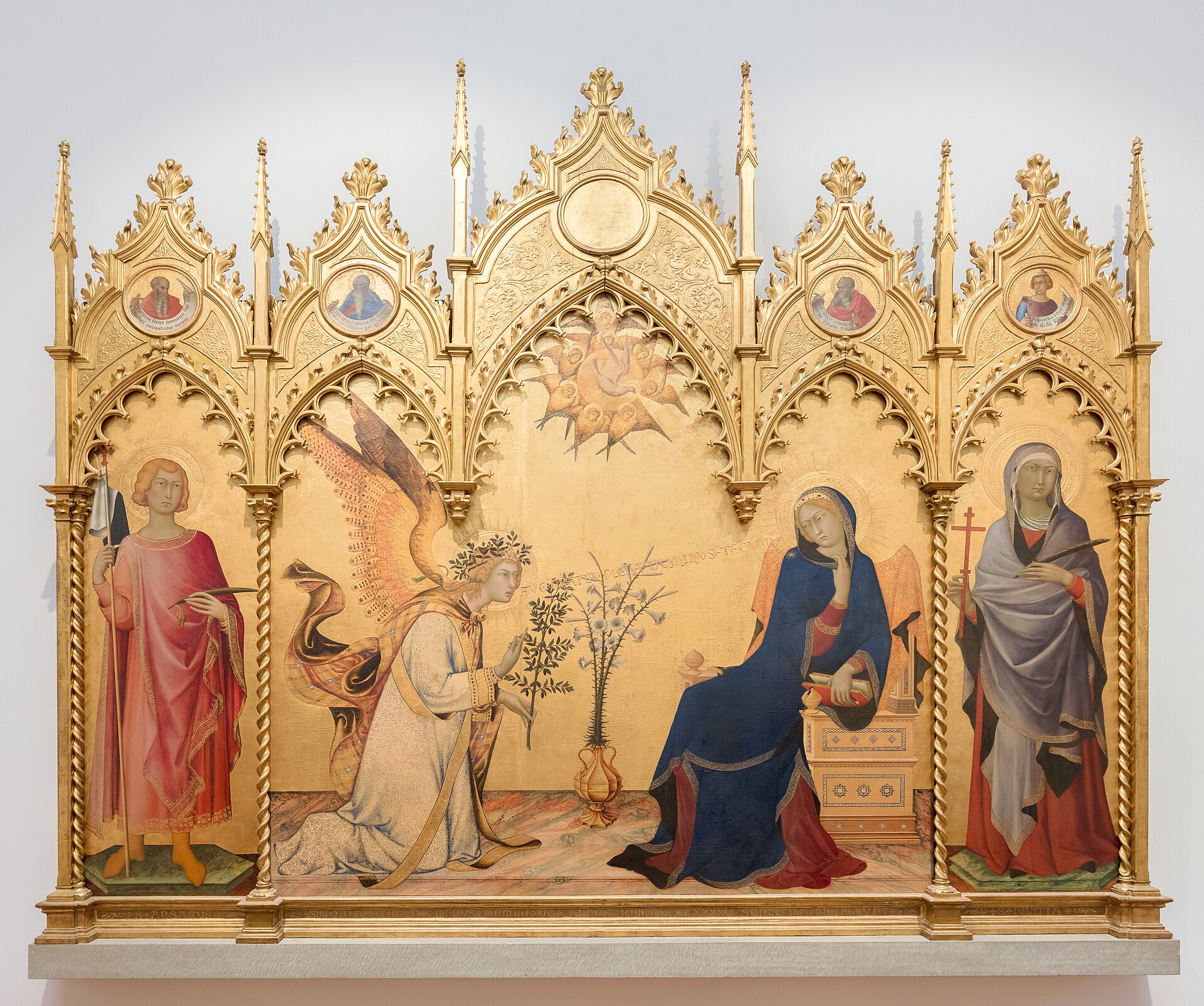
Simone Martini and Lippo Memmi, Annunciation.
Altar of Saint Ansanus, Siena Cathedral, Siena, Italy, 1333.
Tempera and gold leaf on wood
International gothic style hybridizing gothic traditions with bright colors, appealing to aristocratic tastes.
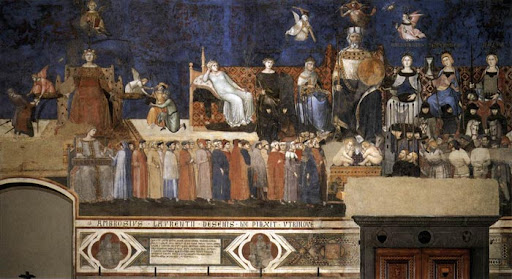
Ambrogio Lorenzetti, Allegory of Good Government.
Sala della Pace, Palazzo Pubblico, Siena, Italy, 1338–1339.
Fresco.
Commission by Siena government, example of secular art. Symbolic representation and reminder of aspects of good government. Adjacent wall has naturalistic panorama depicting effects of good government.
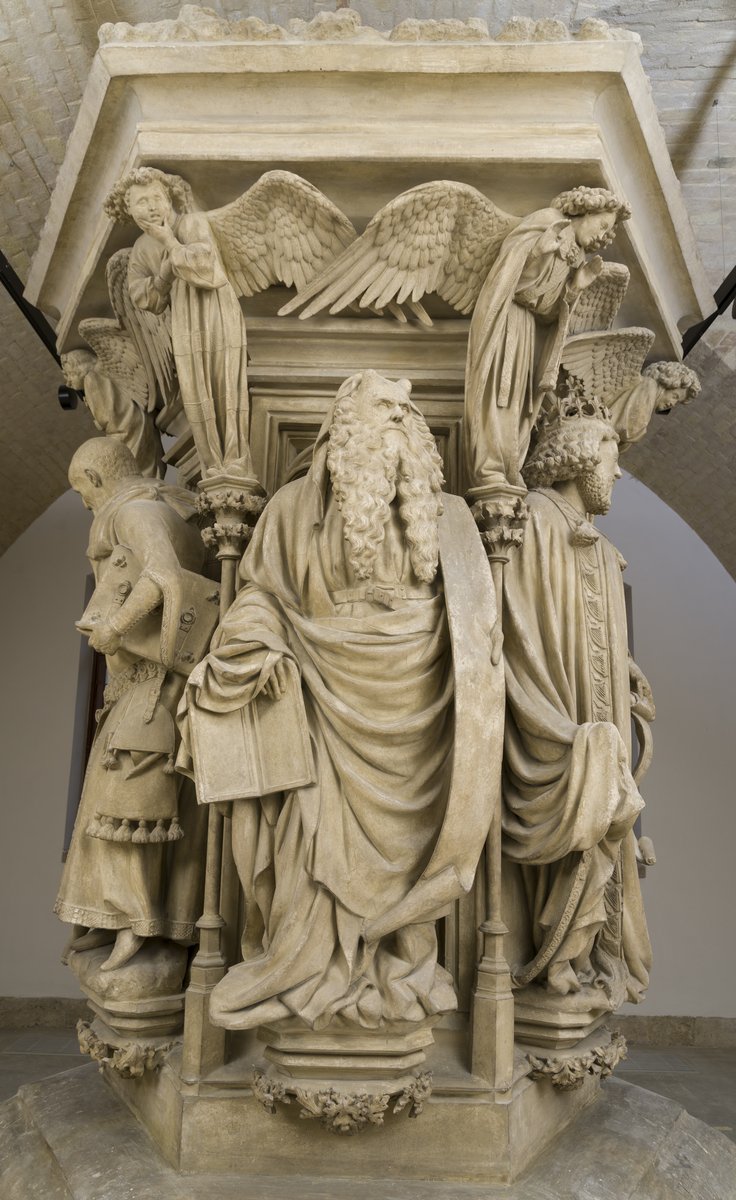
Claus Sluter, Well of Moses.
Chartreuse de Champmol, Dijon, France, 1396–1406.
Limestone, painted and gilded by Jean Malouel.
Commission by Philip the Bold (Duchy Burgundy) for sponsored Cathrusian monastery. Humanized sculpture with focus on naturalism in figure, faces, and drapery.
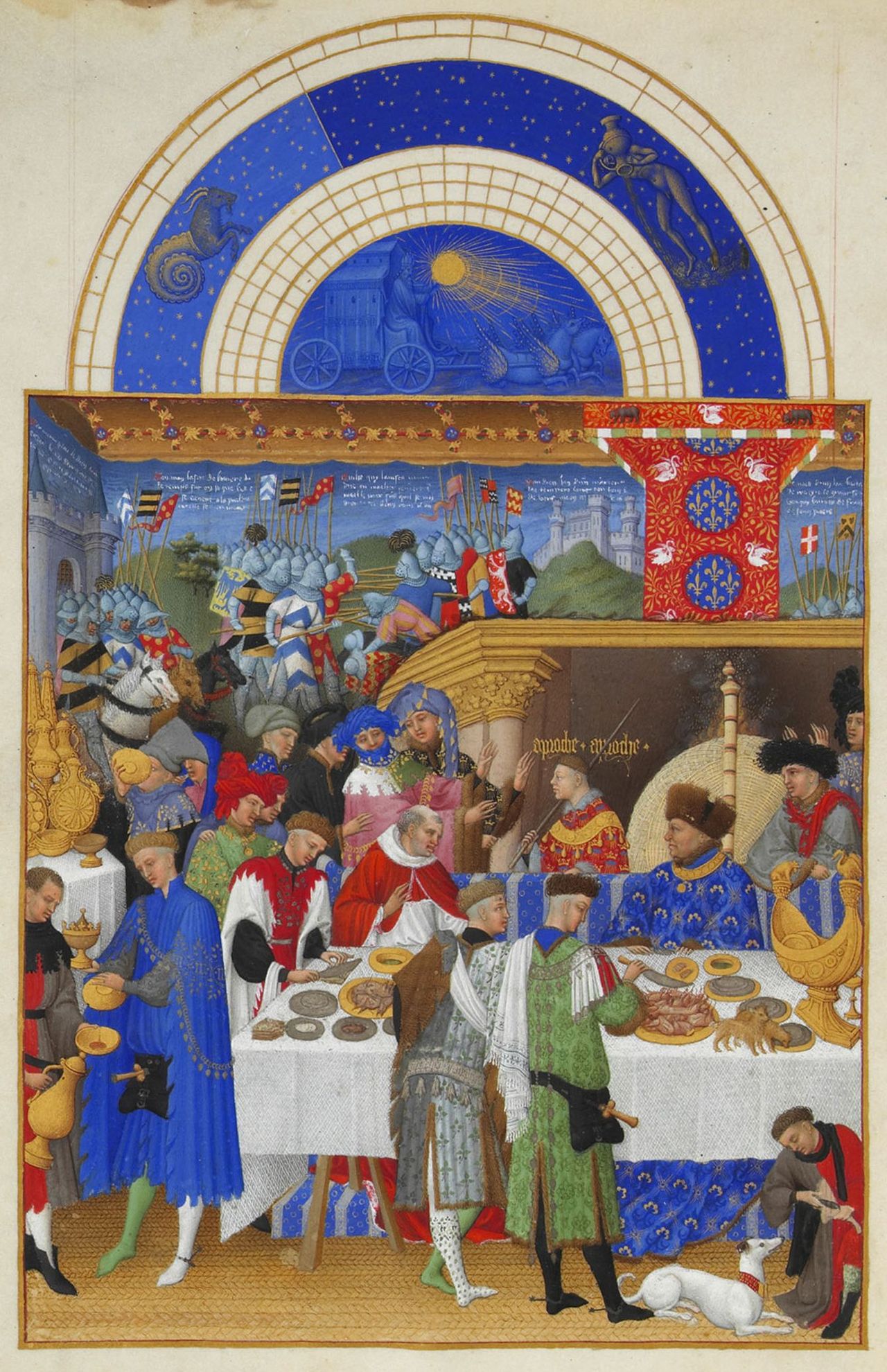
Limbourg brothers (Pol, Herman, Jean), January.
Page from Les Très Riches Heures du Duc de Berry, 1413–1416.
Colors and ink on vellum.
Commission by Jean, duke of Berry, collector of similar manuscripts. Prayer book with art symbolizing life in the duke’s territory with illusionistic representations.
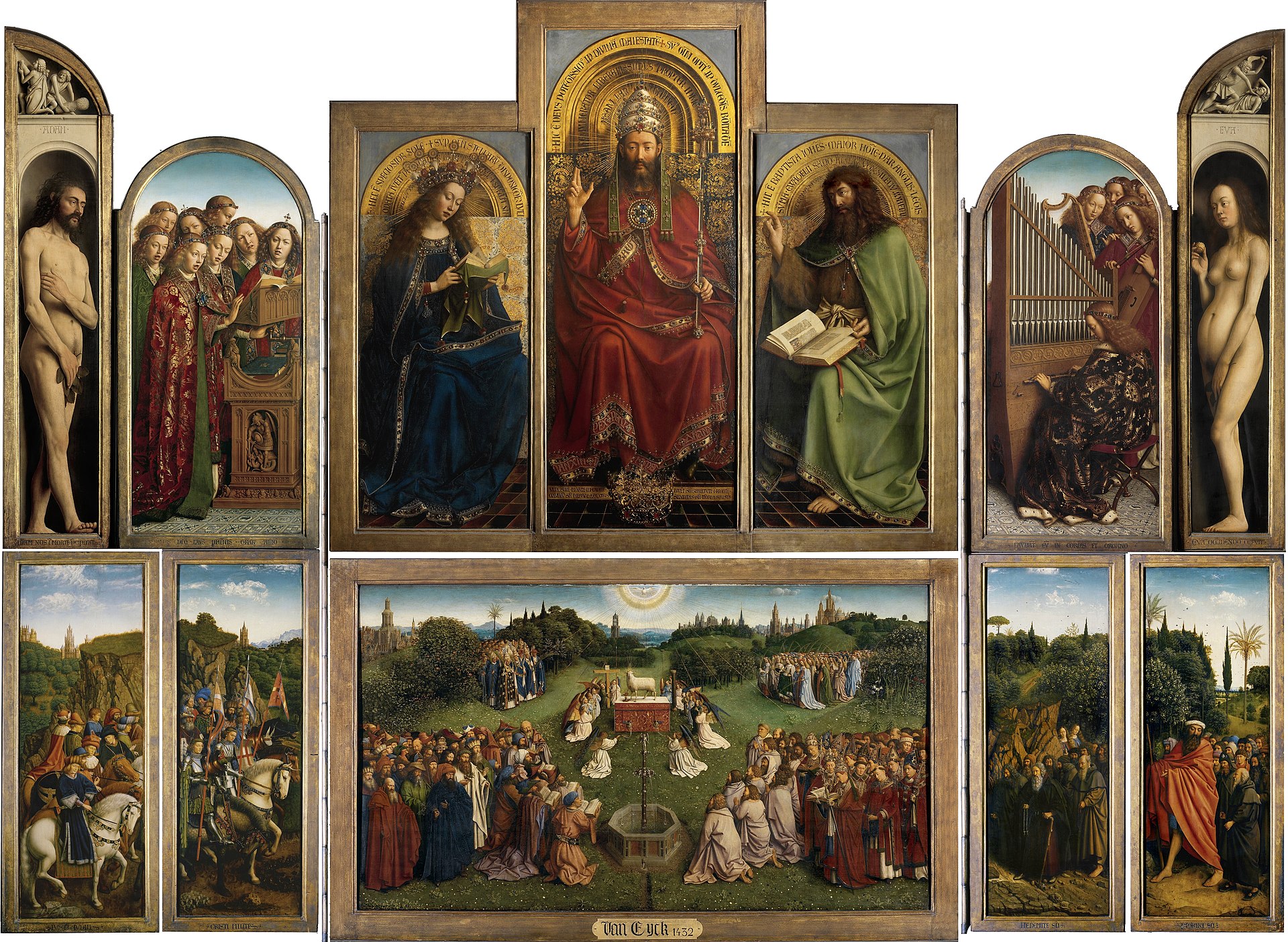
Hubert and Jan van Eyck, Ghent Altarpiece (interior panels).
Saint Bavo Cathedral, Ghent, Belgium, ca. 1423–1432.
Oil on wood.
Depicts human salvation through Christ (Lamb, centered) with God the Father and other holy figures above. Oil paint enables richer color and texture for illusionistic rendering and detail.

Hubert and Jan van Eyck, Ghent Altarpiece (exterior panels).
Saint Bavo Cathedral, Ghent, Belgium, ca. 1423–1432.
Oil on wood.
Depicts the patrons (burgomeister Jodocus Vyd and Elisabeth Borluut) in prayer with annunciation in domestic scenery. Oil paint enables richer color and texture for illusionistic rendering and detail.
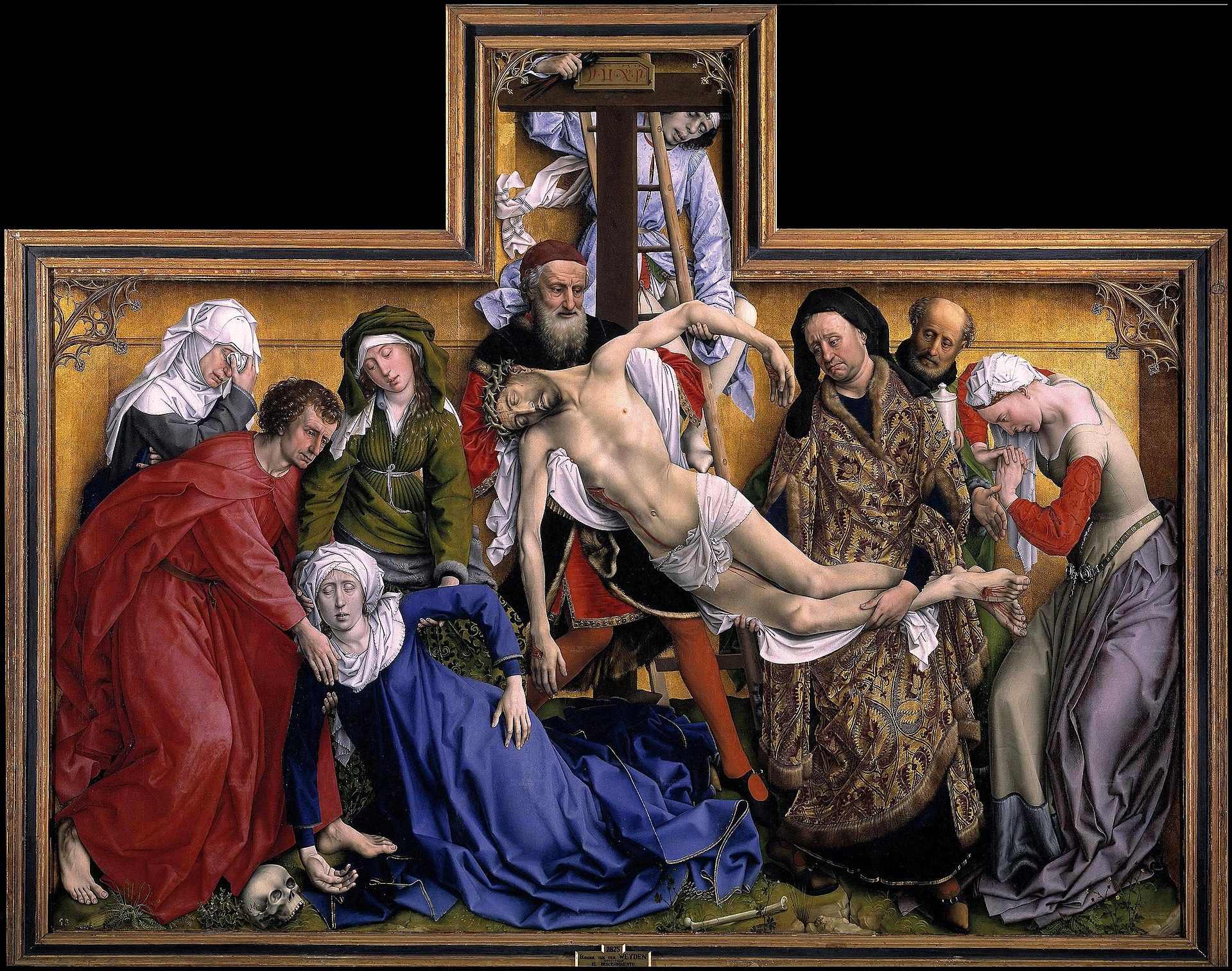
Rogier van der Weyden, Deposition
Center panel of a triptych from Notre-Dame hors-les-murs, Louvain, Belgium, ca. 1435–1442.
Oil on wood.
Commission by archer’s guild. Slight departure from current trends with illusionistic scene boxing in the figures, rather than a naturalistic setting. Figures are represented humanized with no halos and depicting strong emotional expressions.
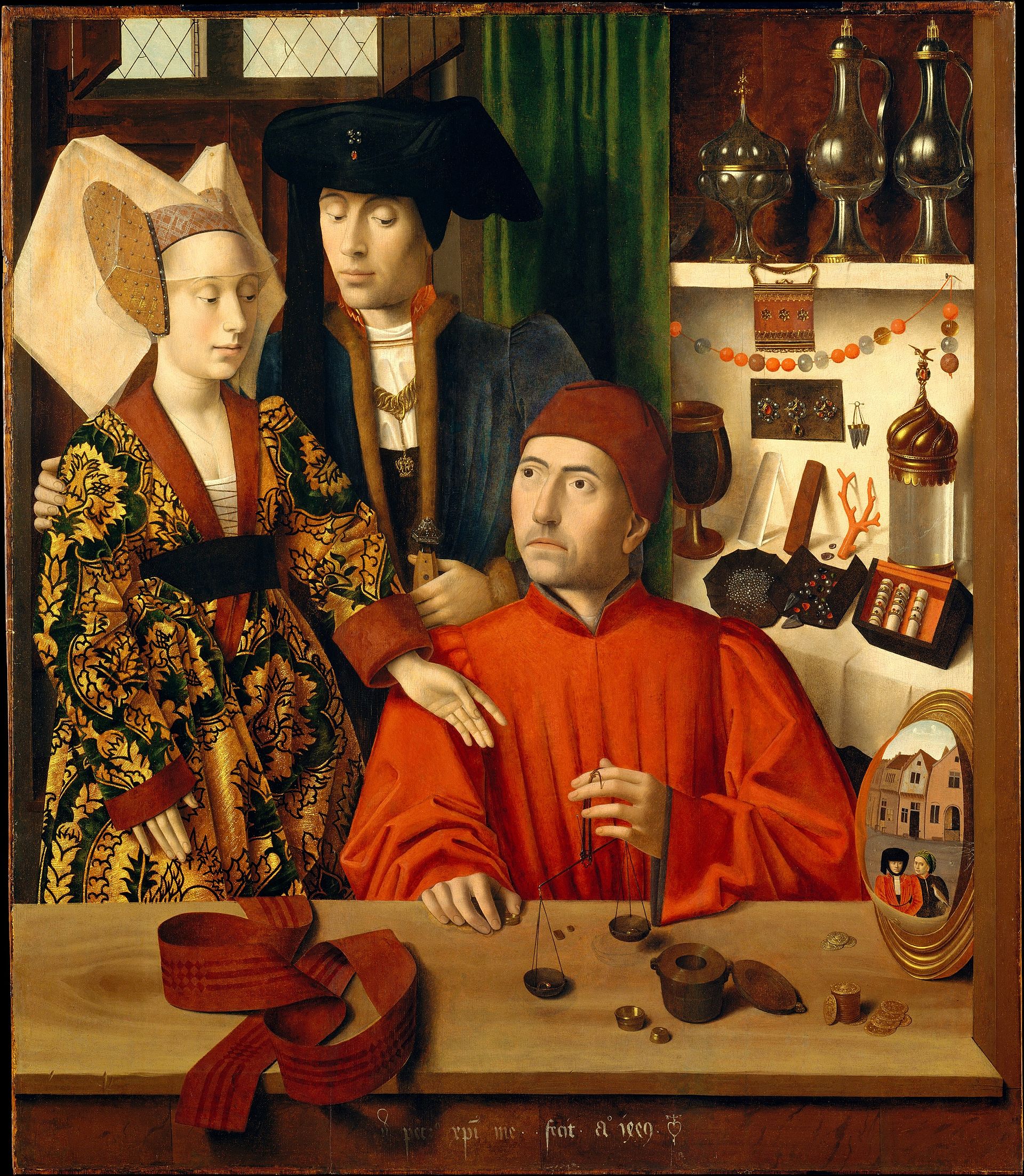
Petrus Christus, A Goldsmith in His Shop.
Bruges, Flanders, 1449.
Oil on wood.
Commission by the goldsmiths’ guild. Example of the increasing role of guilds as patrons of the arts.
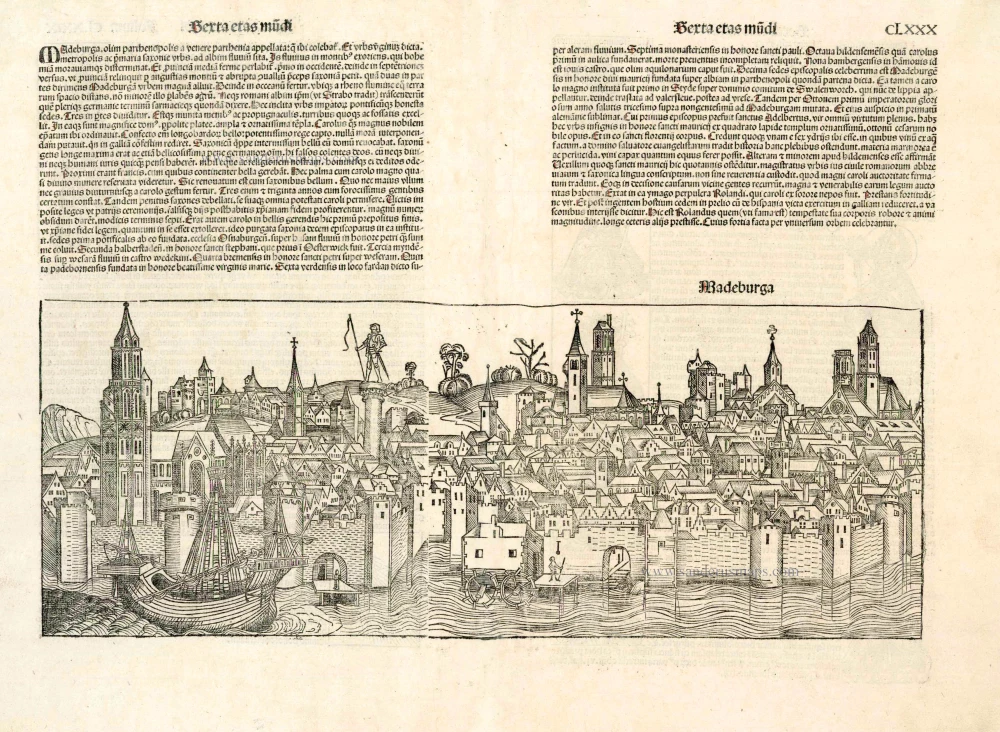
Michael Wolgemut and workshop, Madeburga
Page from the Nuremberg Chronicle, 1493.
Woodcut, printed by Anton Koberger.
Mass production of texts enabled by printing joined with artistic pursuits through carvings and engravings. This work depicts Madeburg for a history book.
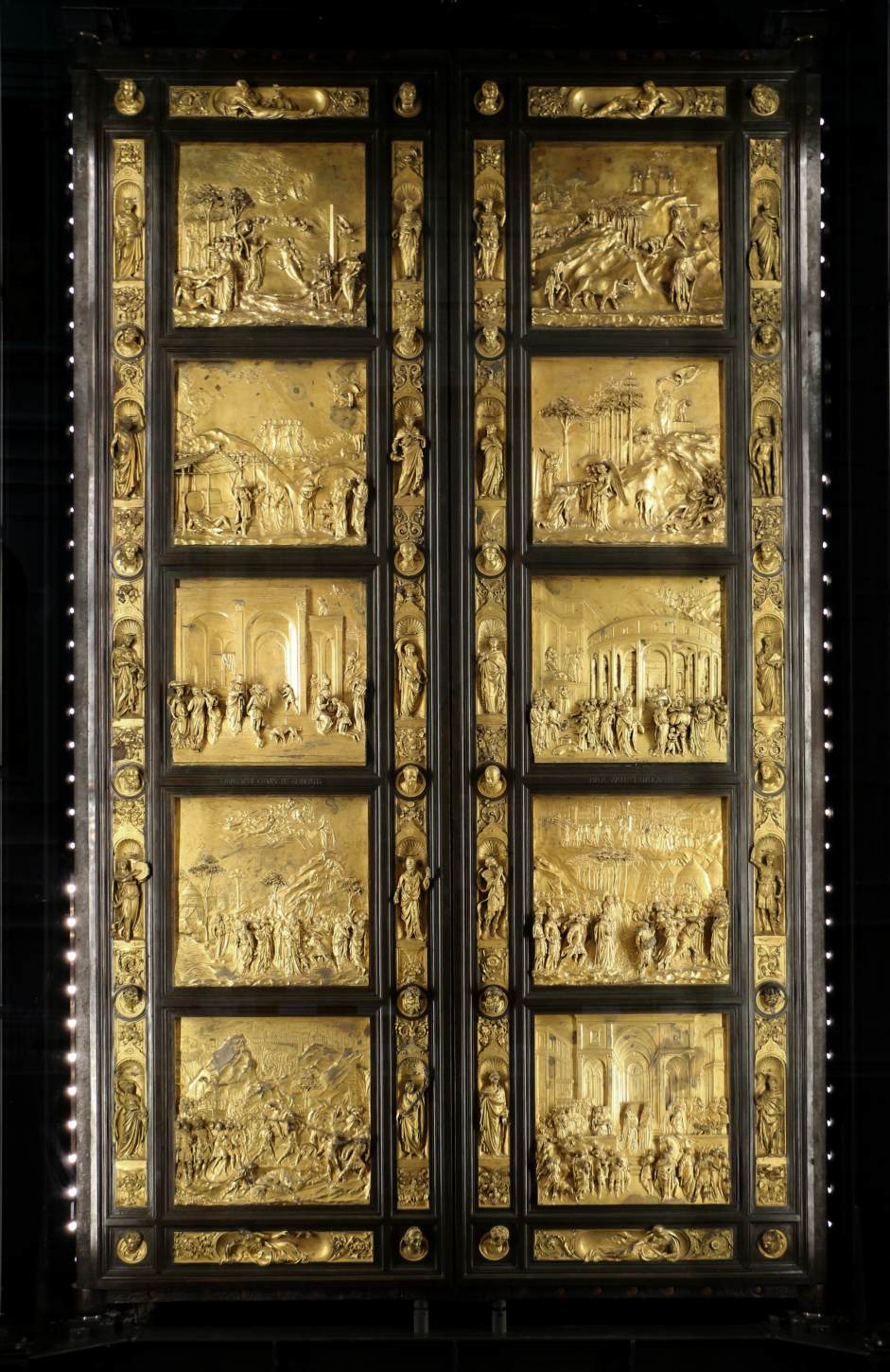
Lorenzo Ghiberti, east doors (Gates of Paradise) of the Baptistery of San Giovanni.
Florence, Italy, 1425–1452.
Gilded bronze.
Second commission by Florentine government to Ghiberti after winning competition around the start of the 15th century. Demonstrating focus on naturalistic and illusionistic rendering, making use of linear perspective.
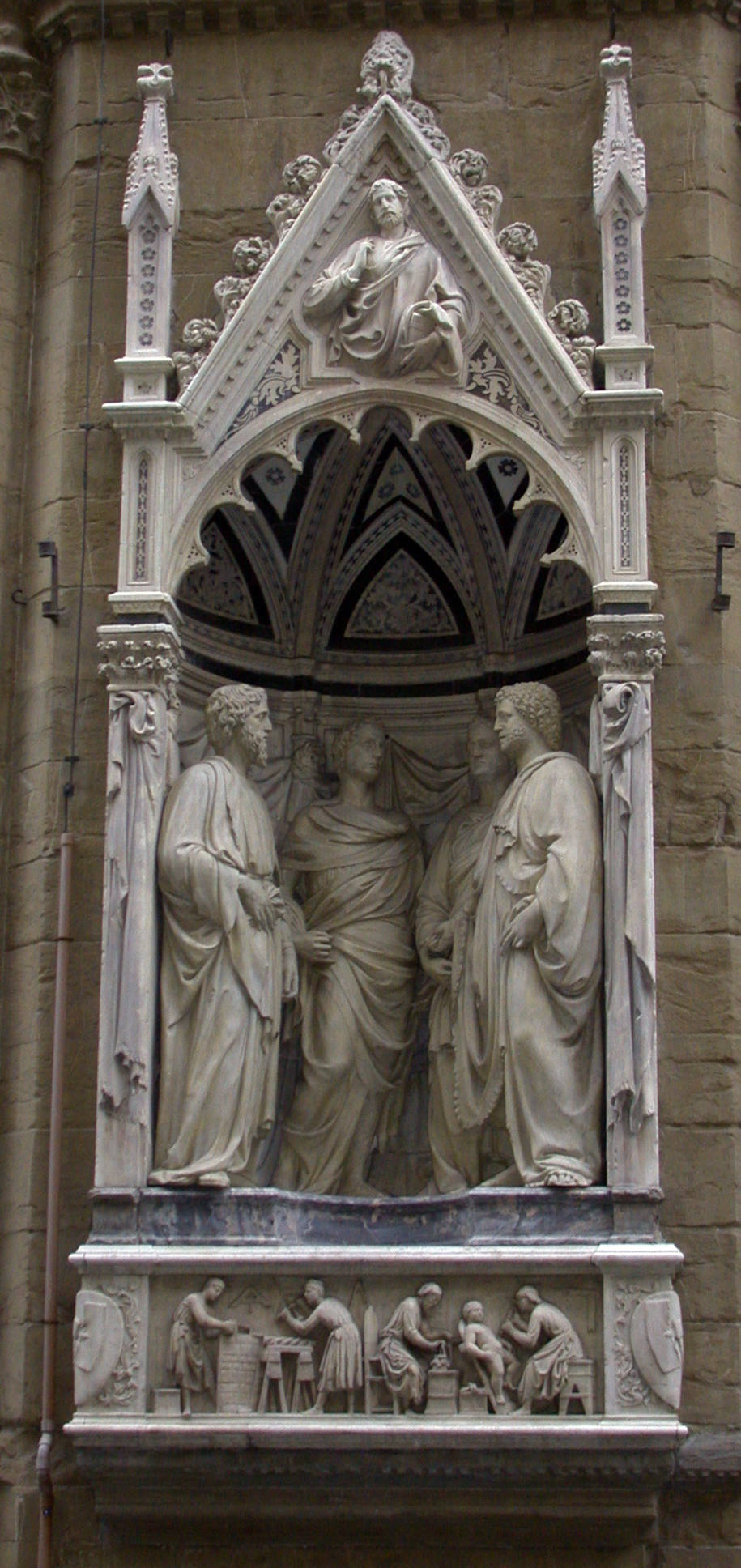
Nanni di Banco, Four Crowned Saints.
Statues in a niche on the north side of Or San Michele, Florence, Italy, ca. 1410–1414.
Marble.
City-mandated commission by woodcarvers’ and stoneworkers’ guild, placed in niches to beautify the city. Influence of classical sculpture, strong humanistic forms with illusionistic interaction between sculpted figures.
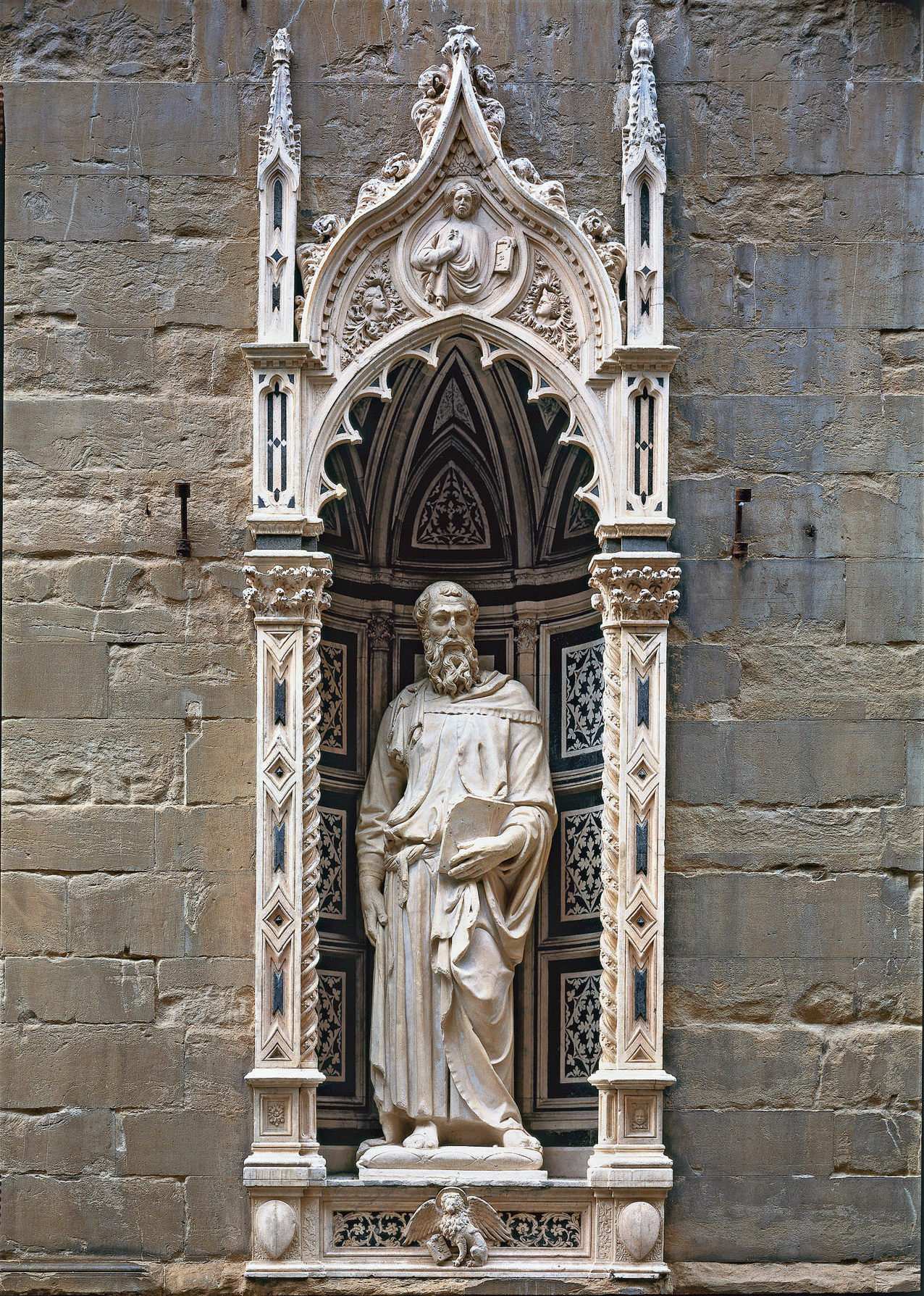
Donatello, Saint Mark.
Statue in a niche on the south side of Or San Michele, Florence, Italy, ca. 1411–1413.
Marble.
City-mandated commission by linnenworkers’ guild, placed in niches to beautify the city. Influence of classical sculpture with focus on human form. Contrapposto with focus on anatomical form followed by clothing drapery.

Donatello, David.
Palazzo Medici. Florence, Italy, ca. 1440–1460.
Bronze.
Callback to classical heroic depictions. Celebration of the human form and humanism brings the nude figure back into positive light.
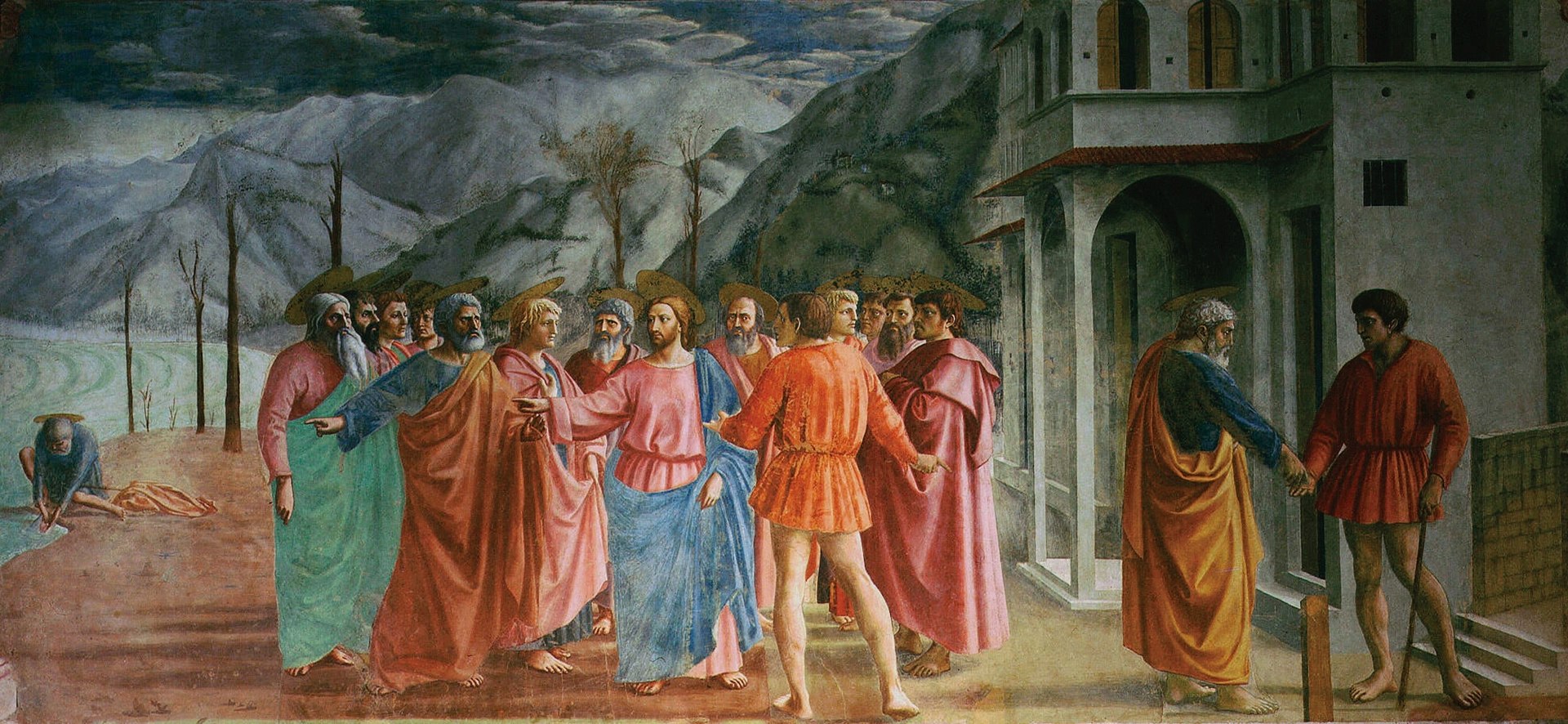
Masaccio, Tribute Money.
Mural in the Brancacci chapel, Santa Maria del Carmine, Florence, Italy, ca. 1424–1427.
Fresco.
One of the first uses of linear perspective in painting. Illusionistic tool with vanishing point aligned with Christ as central figure. The painting conveys a narrative story with humanized interpersonal interactions depicted between the subjects, creating credibility along with the illusionism.
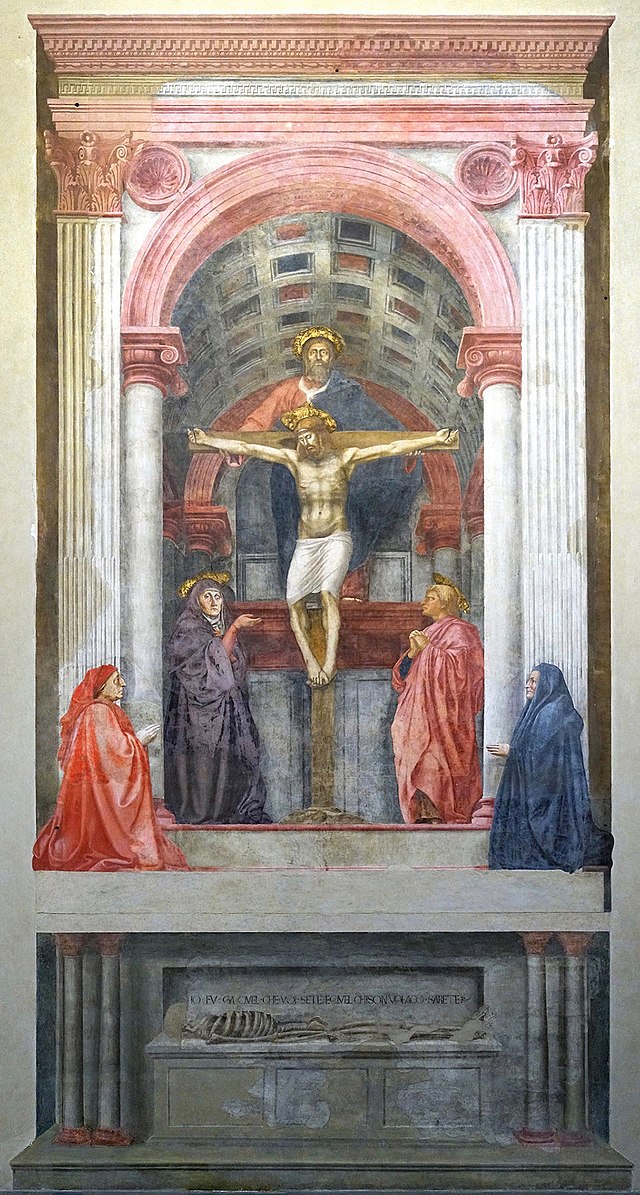
Masaccio, Holy Trinity.
Mural inside Santa Maria Novella, Florence, Italy, ca. 1424–1427.
Fresco.
Immaculate display of linear perspective and illusionism with inspiration from classical architecture. Chooses to depict the Virgin Mary as aged mother of adult child, appropriate for age of Christ at crucifixion, a very humanistic choice. Donor paintings (Lorenzo Lenzi and wife) included.

Filippo Brunelleschi, dome of the Cathedral of Santa Maria del Fiore.
Florence, Italy, 1420–1436.
Several innovations went into the engineering of this technically challenging dome, including a reversible hoist, cantilevered scaffolding, double-shell dome, and herringbone masonry. The technology to build the dome was not yet invented when the cathedral was planned.
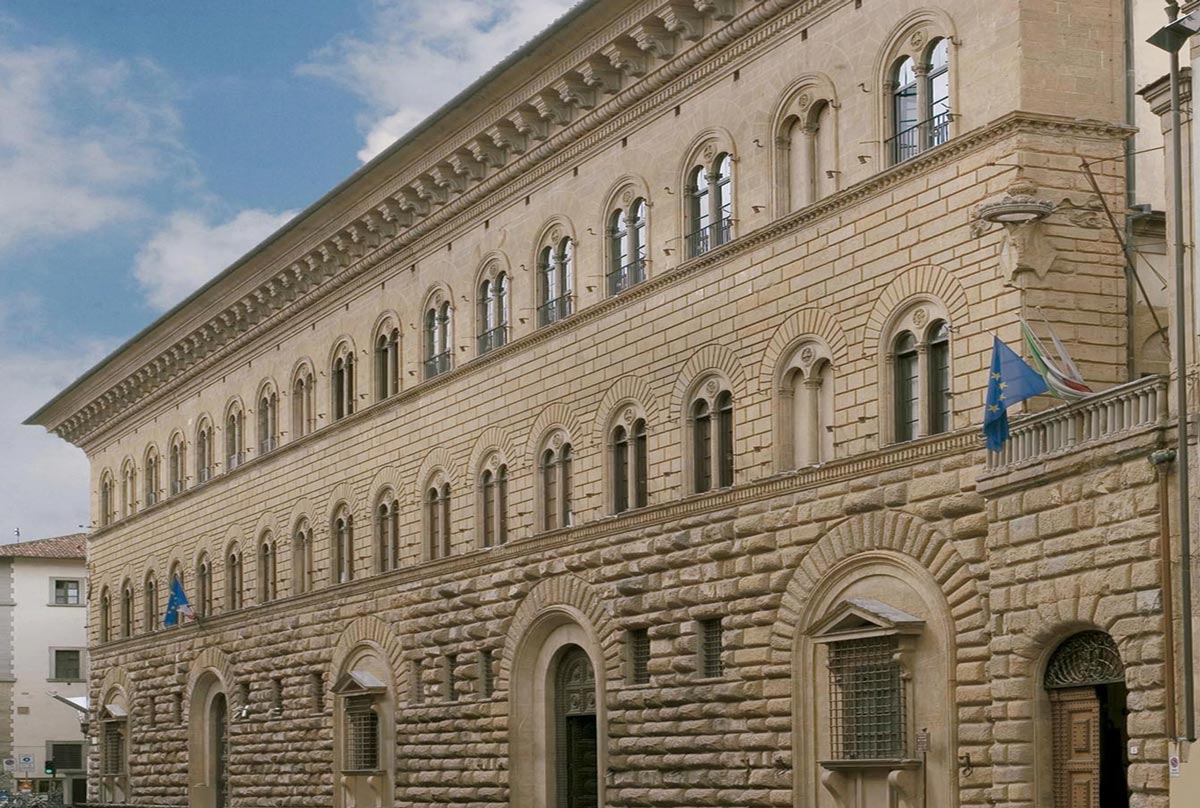
Michelozzo di Bartolommeo, Palazzo Medici-Riccardi.
Florence, Italy, begun 1445.
Rather tame exterior compared to the highly geometric and ordered architecture being built contemporaneously, partially for the Medici family to maintain more acceptable profile in their political environment. The three-layered design with heavy cornice still belies the order of Renaissance architecture and would be an inspiration for many other buildings.
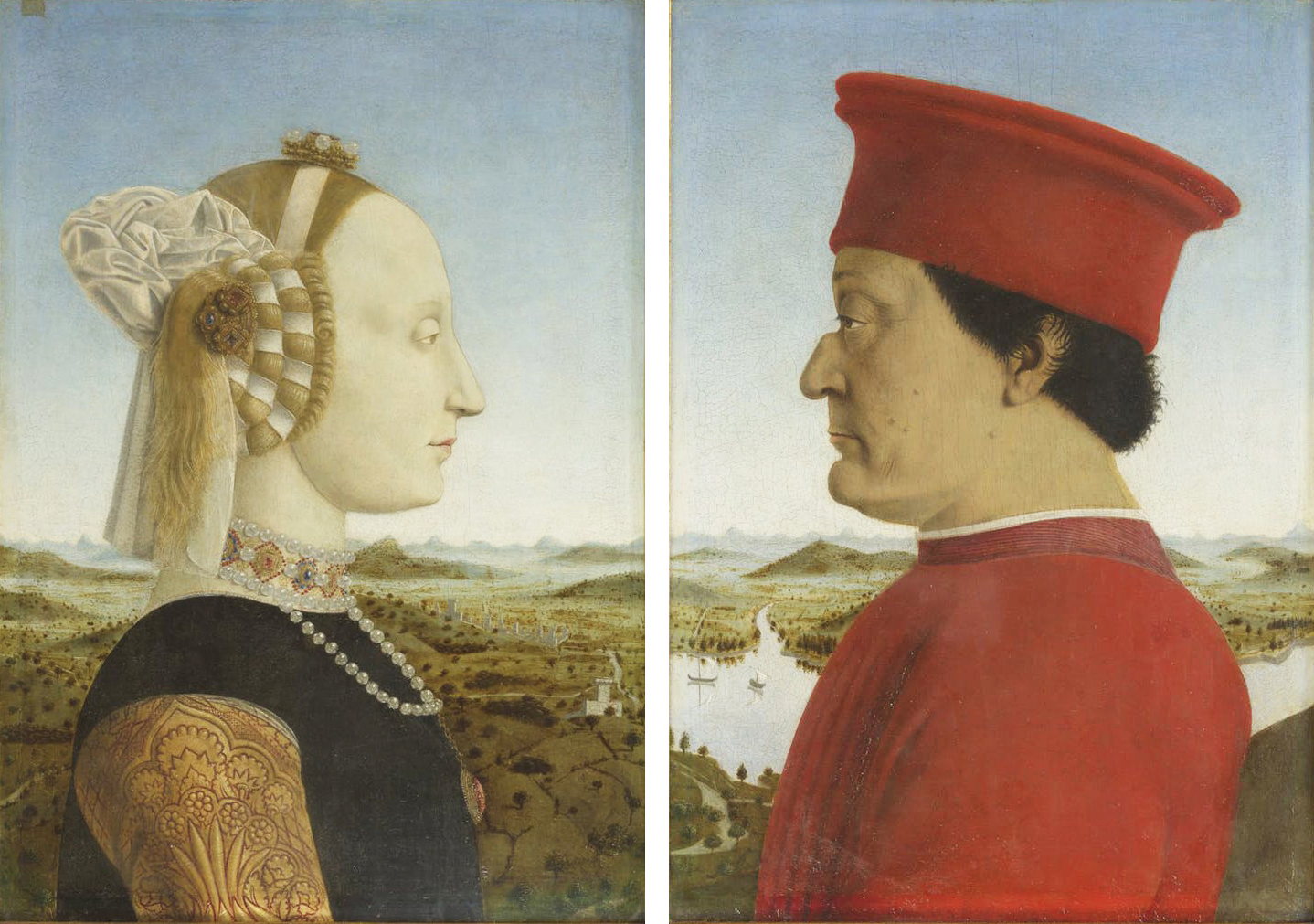
Piero della Francesca, Battista Sforza and Federico da Montefeltro.
ca. 1472–1474.
Oil and tempera on wood in modern frame.
Commission by duke of Urbino honoring his late wife. Profile portraits call back to classical coinage depicting leaders.

Leon Battista Alberti, west facade of Sant’Andrea.
Mantua, Italy, begun 1472.
Commission by Marquis Ludovico Gonzaga. Facade draws strong inspirations from classical temples and triumphal arches.

Andrea Mantegna, interior (walls) of the Camera Picta (Painted Chamber).
Palazzo Ducale, Mantua, Italy, 1465–1474.
Fresco.
Commission by Marquis Ludovico Gonzaga. Elaborate fresco program depicts an illusionistic patio opening onto a landscape, glorifying the patron’s family.
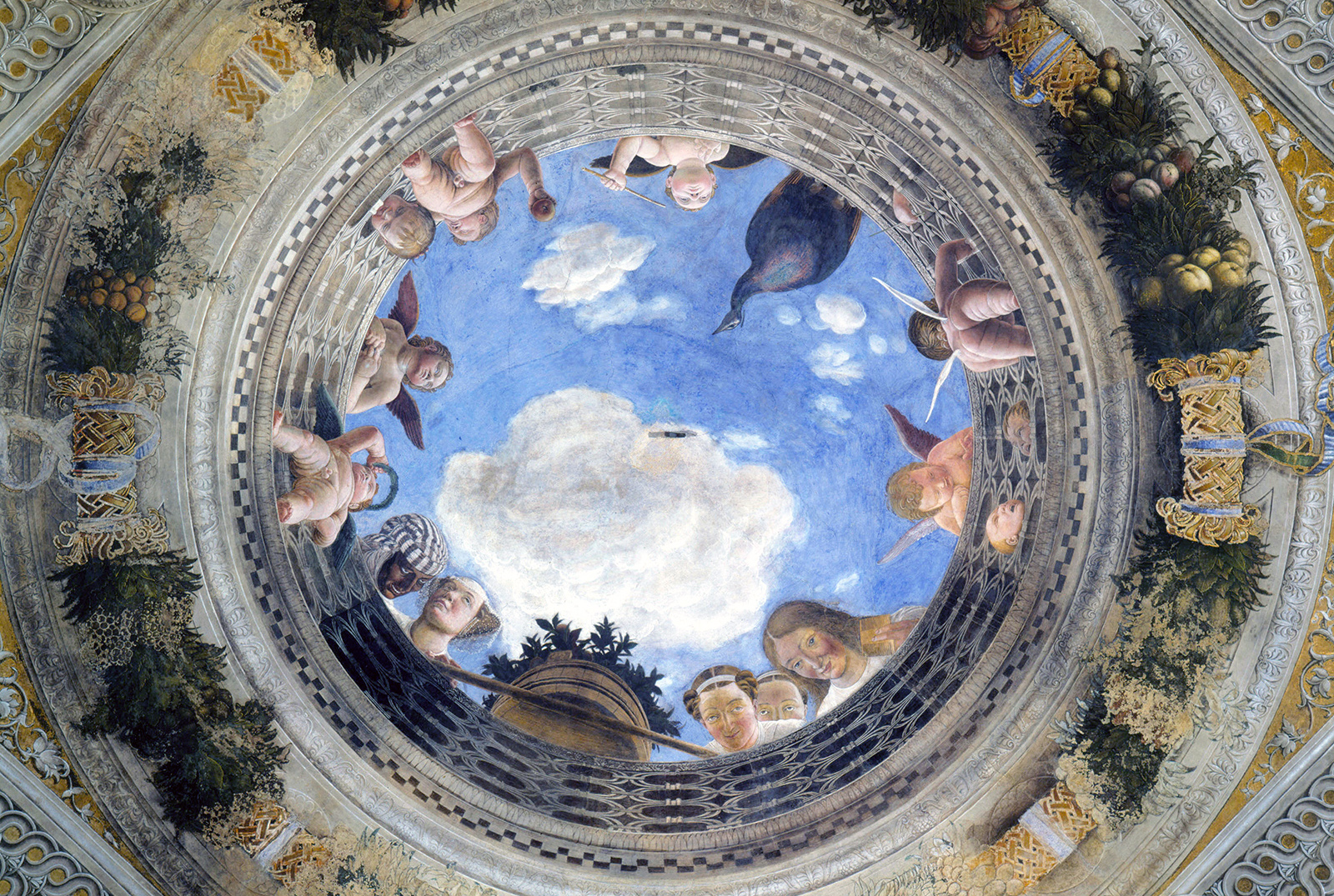
Andrea Mantegna, interior (ceiling trompe l'oeil) of the Camera Picta (Painted Chamber).
Palazzo Ducale, Mantua, Italy, 1465–1474.
Fresco.
Commission by Marquis Ludovico Gonzaga. Highly illusionistic fresco on the ceiling that seeks to trick the eye.

Sandro Botticelli, Birth of Venus.
ca. 1484–1486.
Tempera on canvas.
Secular painting of pagan subjects, for display in the Medici palace. Painting represents a departure from some of the contemporary illusionistic techniques and focus on precise human forms. The female nude may have brought criticism in prior years, but the influence of the Medici, growing Renaissance culture, and connections between beauty and the divine protected this painting.
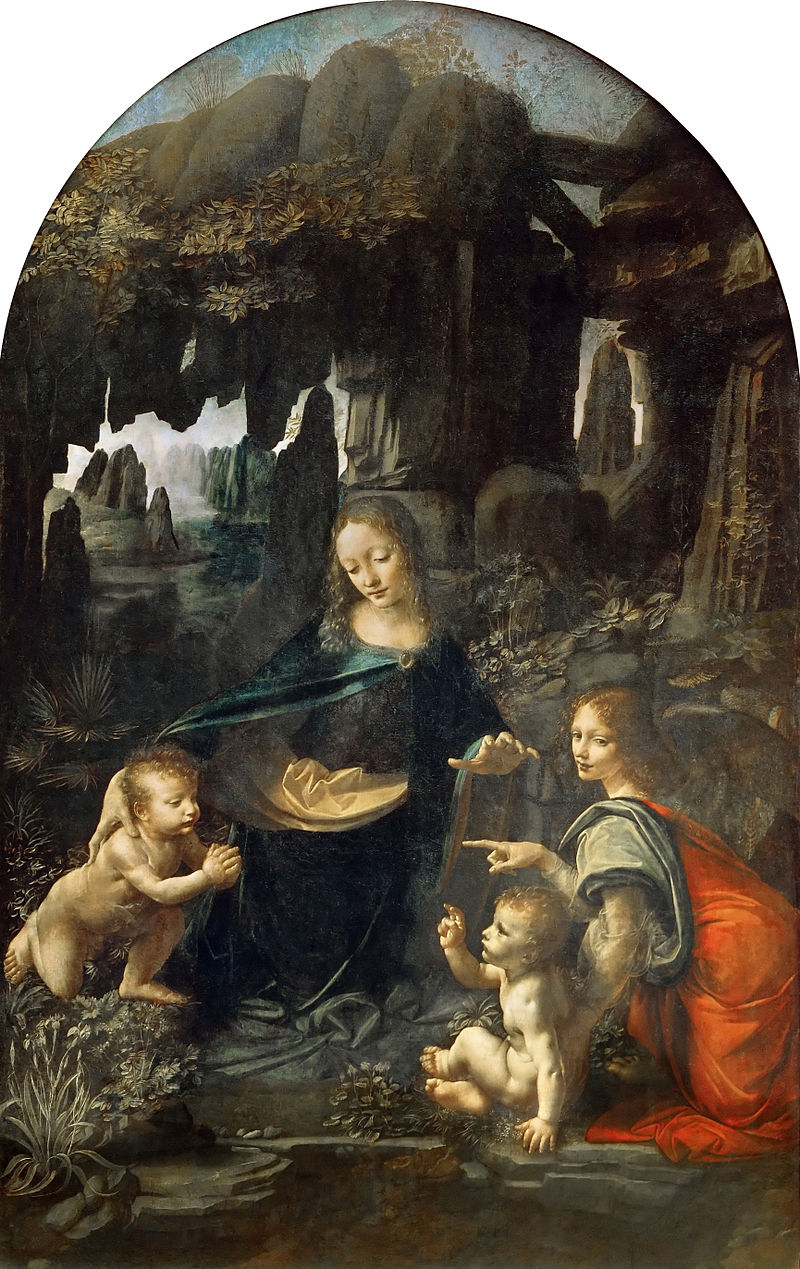
Leonardo da Vinci, Madonna of the Rocks.
San Francesco Grande, Milan, Italy, 1483–1490.
Oil on wood.
A Leonardo composition depicting hallmark features including a pyramidal composition, chiaroscuro, sfumato shading, and an overall mysterious illusionistic landscape.
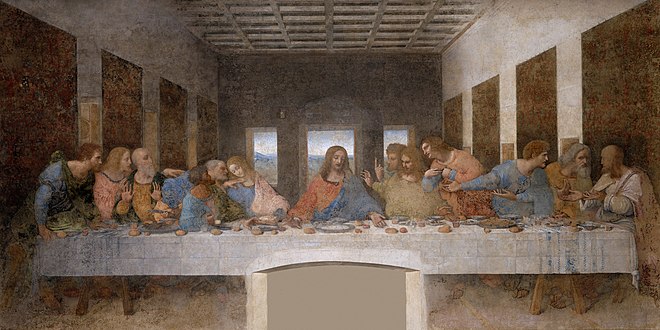
Leonardo da Vinci, Last Supper.
Refectory, Santa Maria delle Grazie, Milan. ca. 1495–1498.
Oil and tempera on plaster.
Illusionistic and humanized composition making use of linear perspective and detailed human expressions and emotions. The fresco was experimental, with painting on dry plaster that was not very durable.
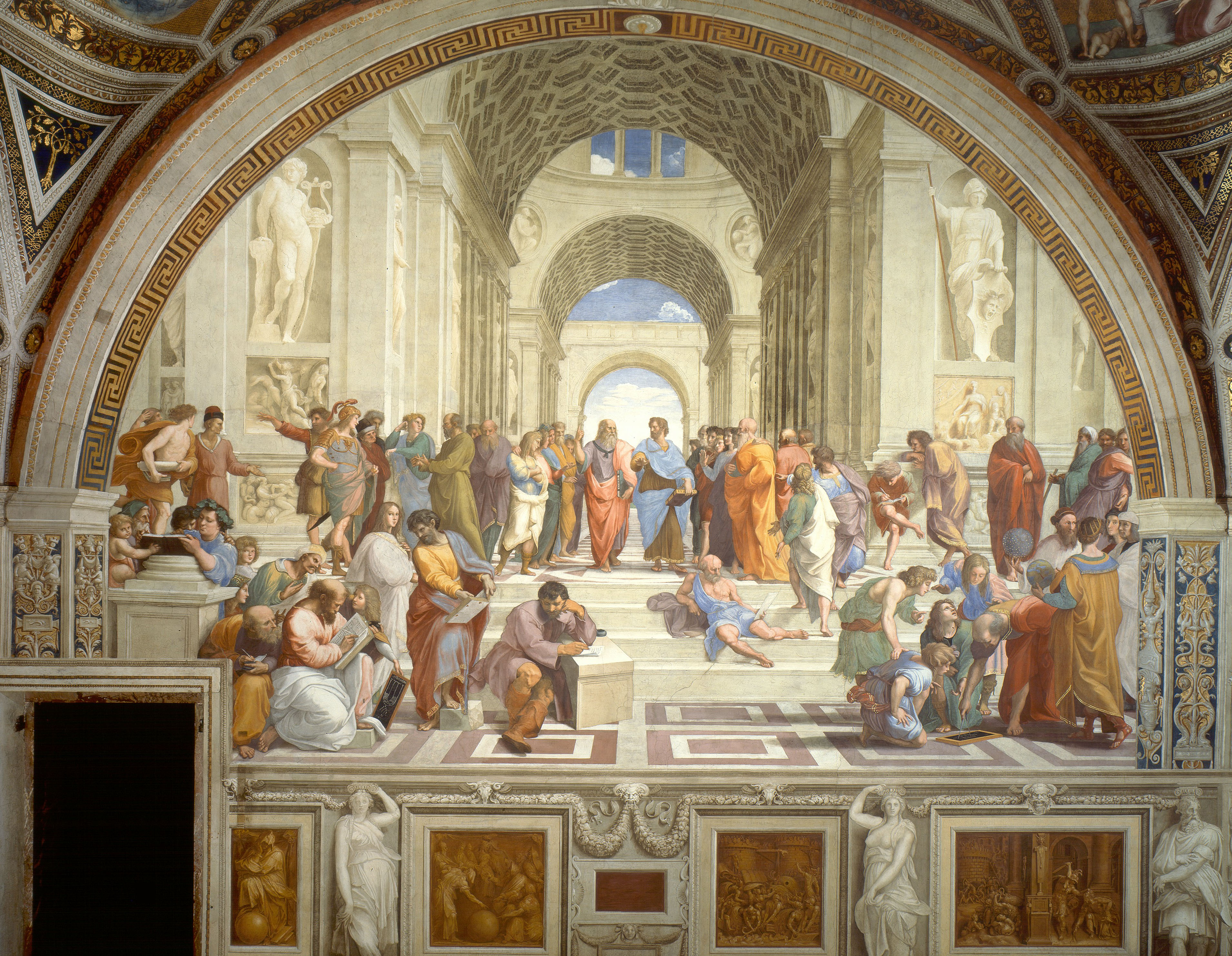
Raphael, Philosophy (School of Athens).
Stanza della Segnatura, Apostolic Palace, Vatican City, Rome, Italy, 1509–1511.
Fresco.
Commission by Julius II, this painting of secular and pagan figures in the Papal apartments represents one of four virtues seen as important to the Papacy while also connecting Papal grandeur and power to classical antiquity.

Michelangelo Buonarroti, David.
Piazza della Signoria, Florence, Italy, 1501–1504.
Marble.
Commission by the Florentine government following the expulsion of the Medici, depicts David as a symbol of Florence and its independence over tyranny as a republic, casting a watchful eye towards Rome, poised to spring into action.
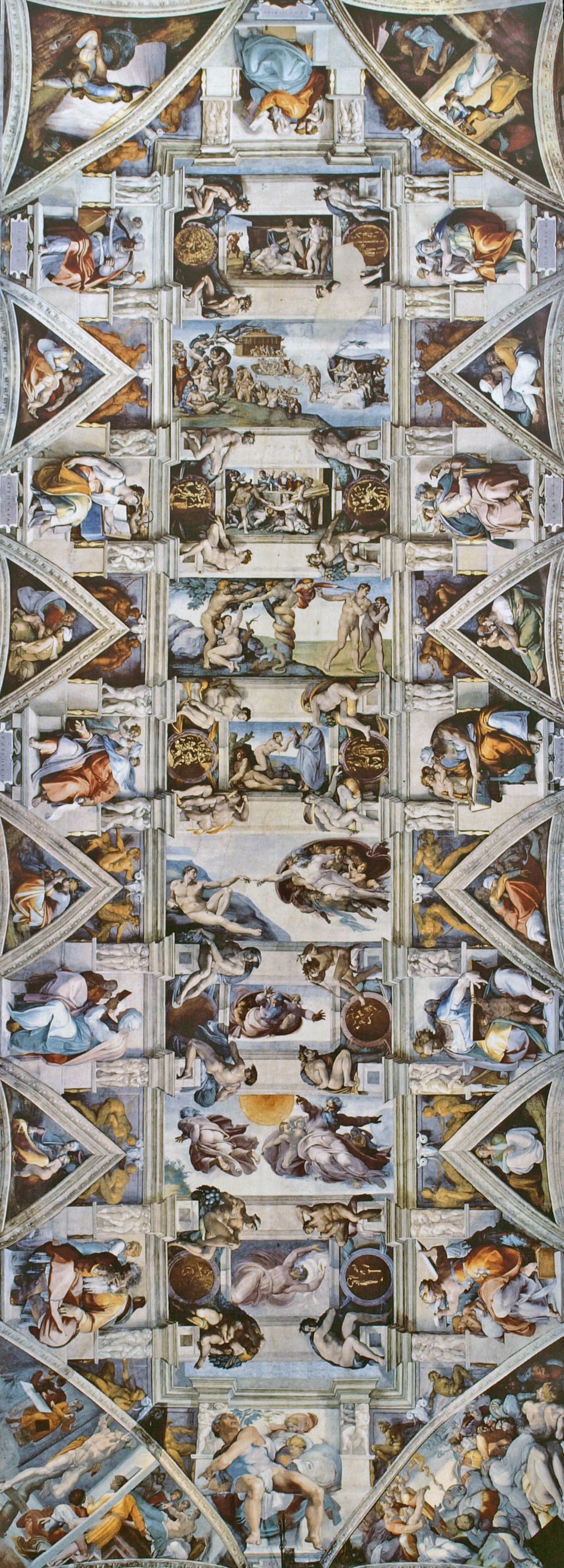
Michelangelo Buonarroti, ceiling of the Sistine Chapel.
Vatican City, Rome, Italy, 1508–1512.
Fresco.
Commission by Julius II. Michelangelo shows his sculptor roots through the rendering of figures in this story of creation and fall of man, foreshadowing salvation through Christ.
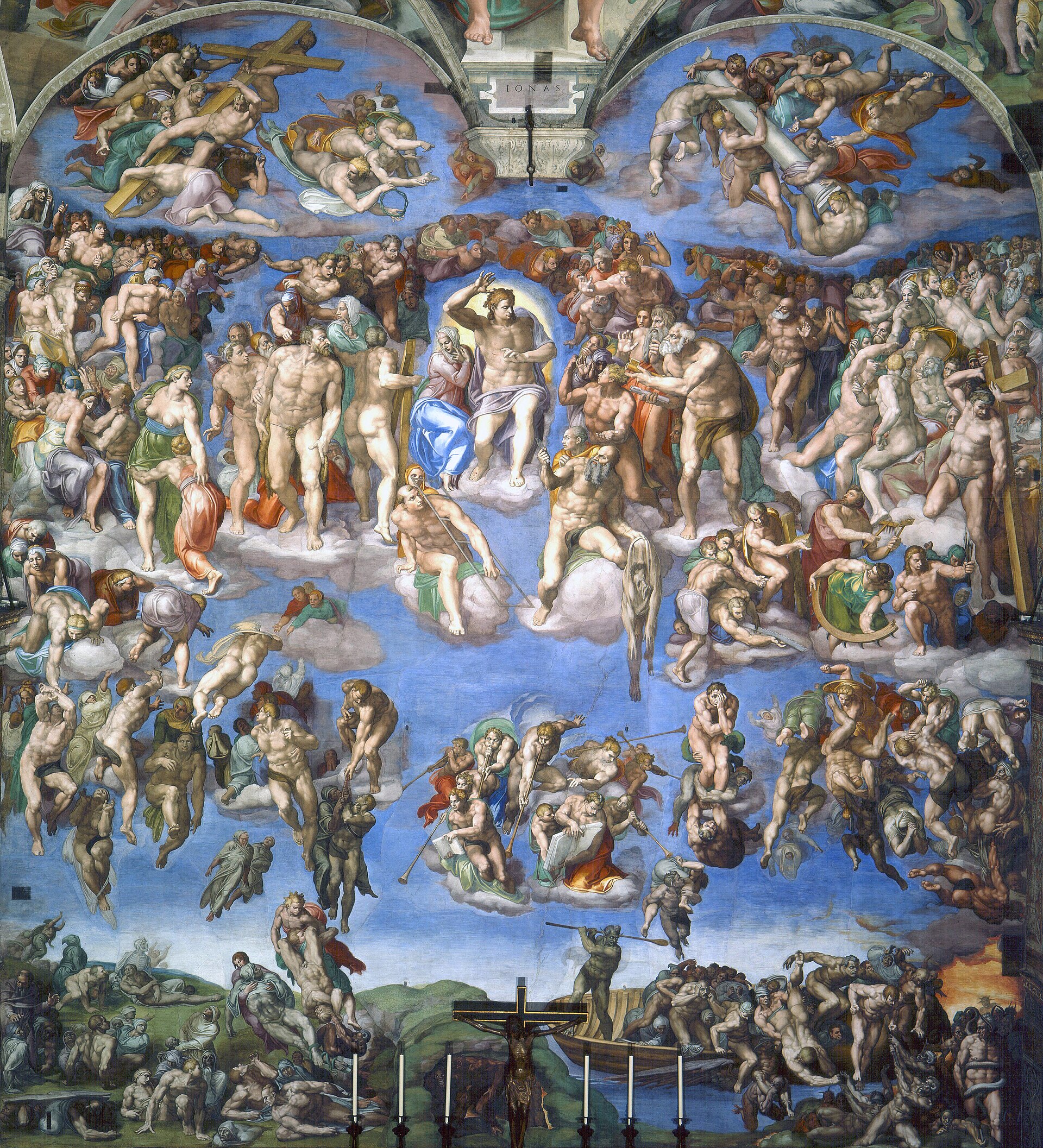
Michelangelo Buonarroti, Last Judgment.
Altar wall of the Sistine Chapel, Vatican City, Rome, Italy, 1536–1541.
Fresco.
Later commission by Paul III. Continues Michelangelo’s sculptoral style in the figures, showing a terrifying scene of the end days with an imposing Christ figure and brutal torture of the damned by demons.
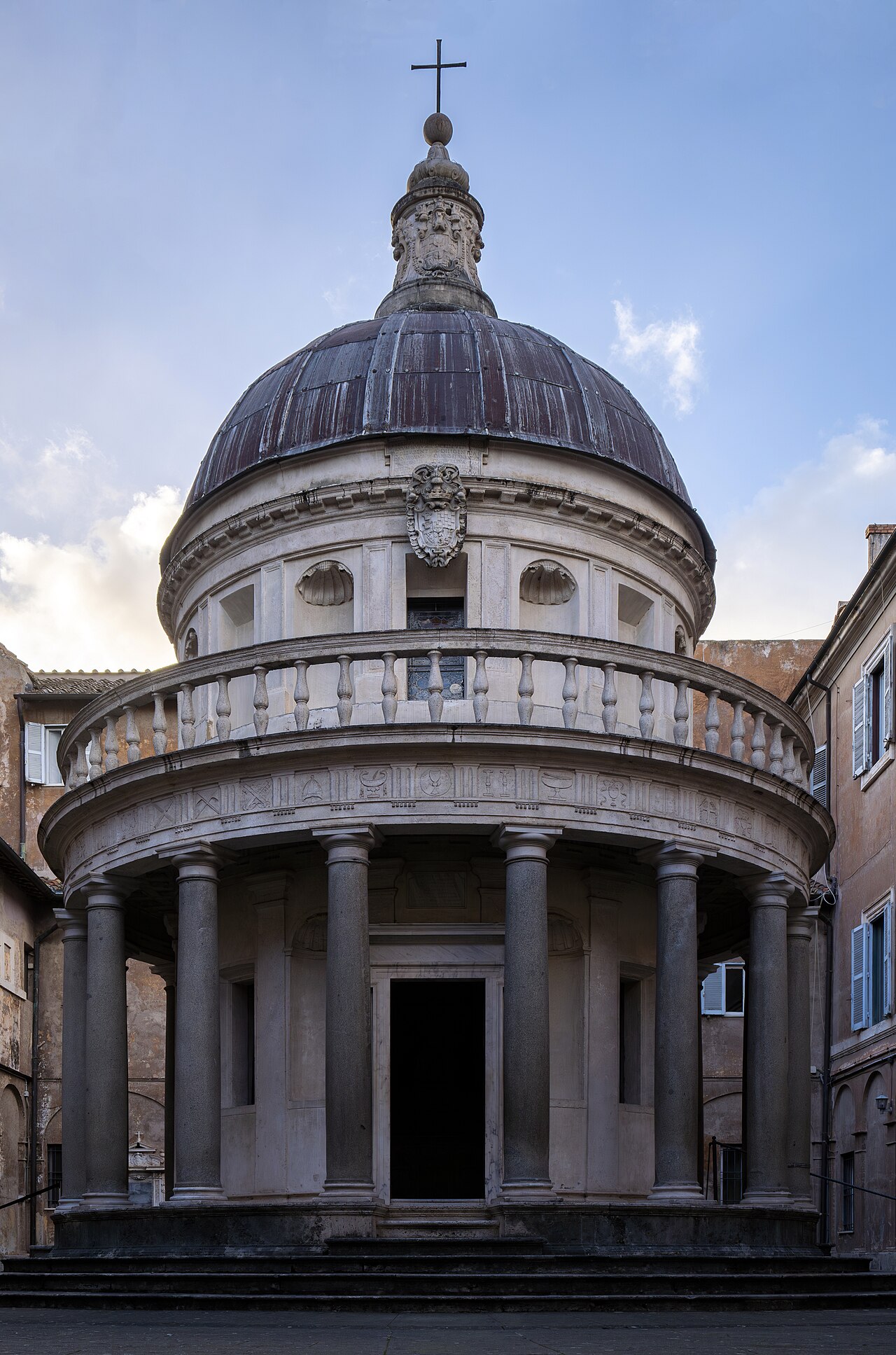
Donato d’Angelo Bramante, Tempietto.
San Pietro in Montorio, Rome, Italy, begun 1502.
Commission by King Ferdinand and Queen Isabella of Spain. The central-plan circular temple calls back to ancient classical circular temples in a first for Renaissance architecture, still with distinct focus on precise geometric ratios and forms with contemporary Renaissance styling.

Giovanni Bellini, Madonna and Child with Saints (San Zaccaria Altarpiece).
Venice, 1505.
Oil on wood.
Depicts the vibrant colors hallmark of High Renaissance Venetian painting. Carefully coordinated with the church’s interior, the painting depicts sacra conversazione (holy conversation), depicting the characters in a unified space, here without character interaction.
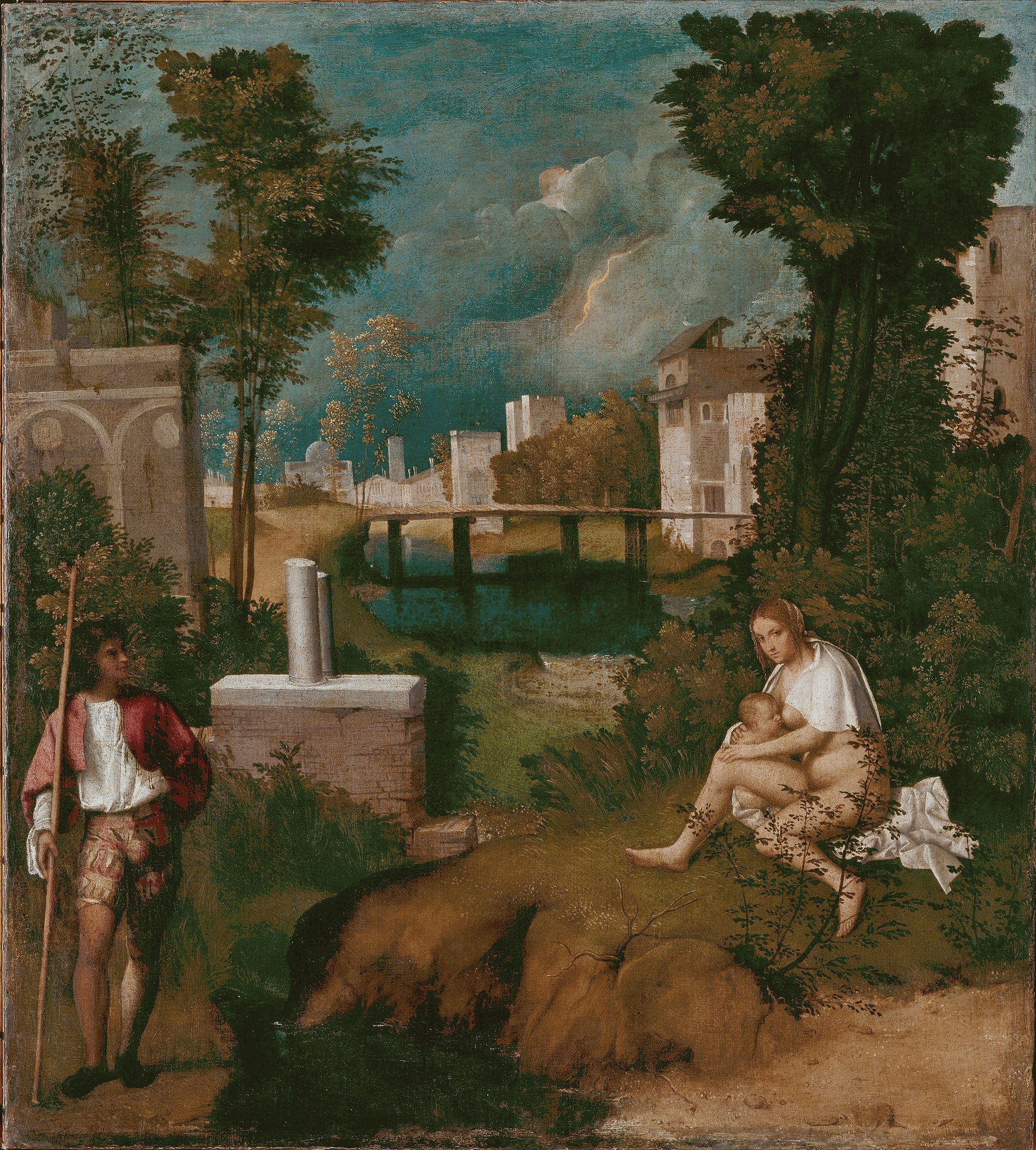
Giorgione da Castelfranco, The Tempest.
Venice ca. 1509–1510.
Oil on canvas.
Using the newly developing poetic manner of painting, this piece does not depict a definite concrete story or real-world subject. The subjects of a nursing mother and male figure with a staff, pushed to the edges of the painting, in a natural city environment with stormy skies defies singular interpretations.
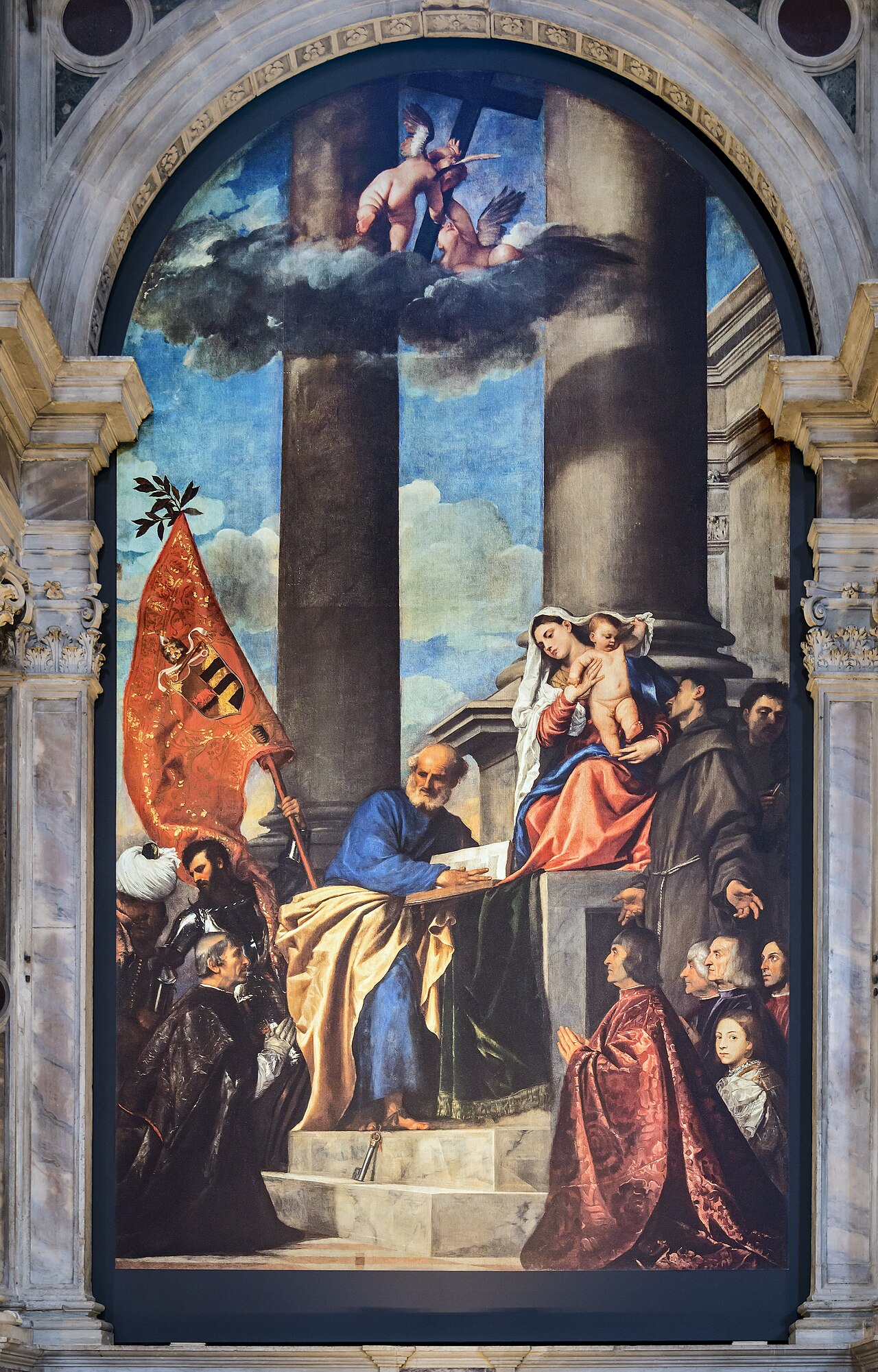
Titian, Pesaro Madonna, 1519–1526.
Pesaro Chapel, Santa Maria Gloriosa dei Frari, Venice.
Oil on canvas.
Commission by Jacopo Pesaro, commander of the papal fleet. Composition involves an asymmetric pyramidal structure depicting a more dynamic scene emphasizing the courtly nature of the Madonna with child, with illusionistic techniques (perspective) taking into account the viewer’s position.
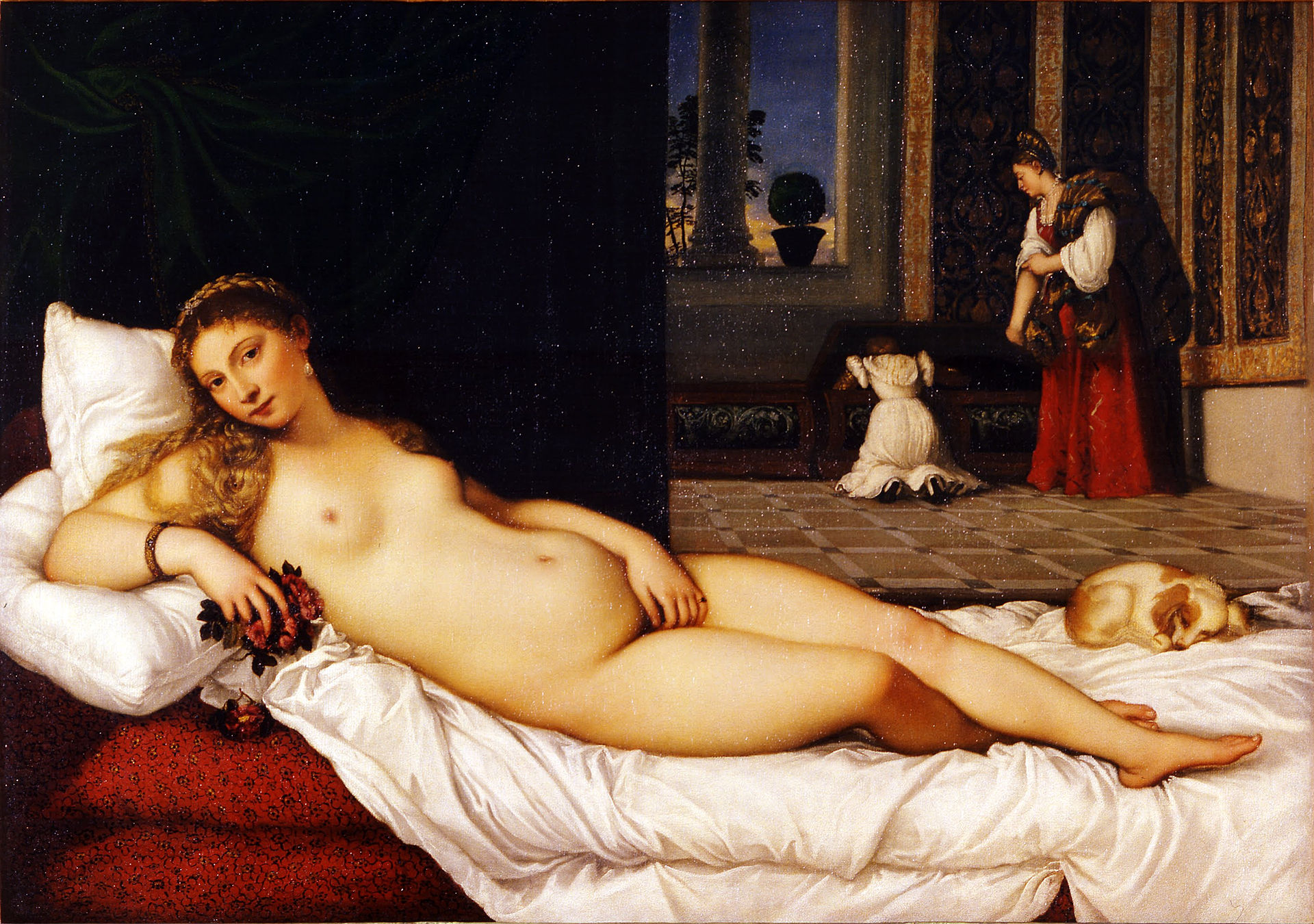
Titian, Venus of Urbino.
Urbino, 1536–1538.
Oil on canvas.
Probable commission by Guidobaldo II, duke of Urbino. Nude female in a domestic setting, later named with the title elevating her to classical mythology. The piece makes powerful use of color to guide the composition.
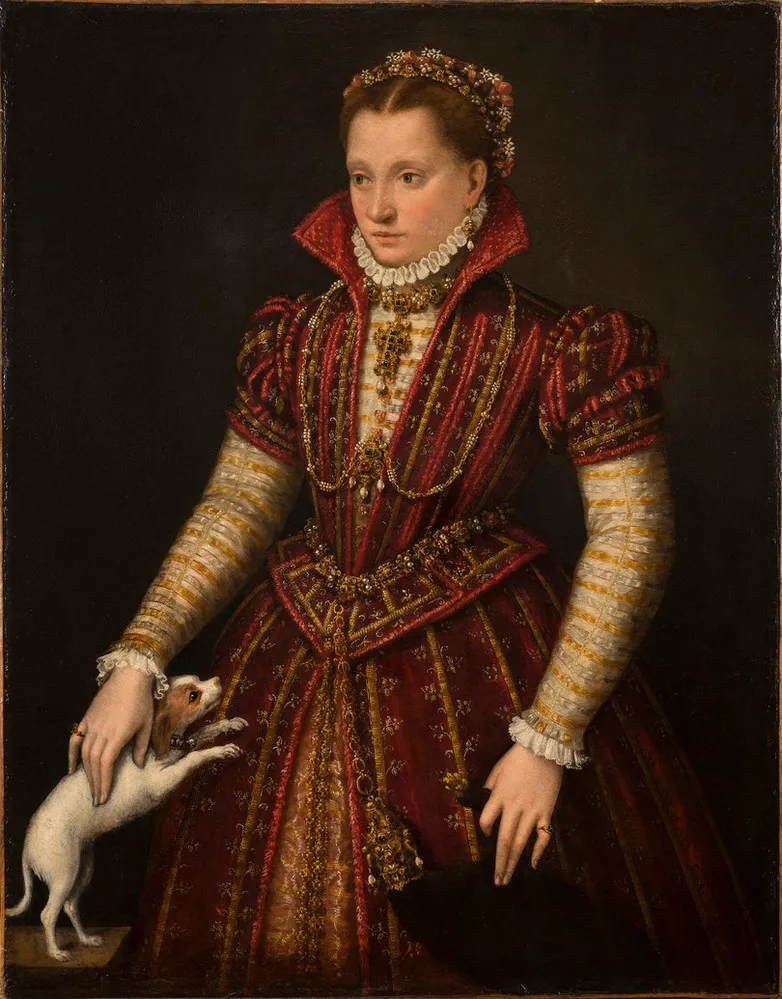
Lavinia Fontana, Portrait of a Noblewoman.
ca. 1580.
Oil on canvas.
Lavinia is one of few female Renaissance painters, the one with the largest surviving collection of works.
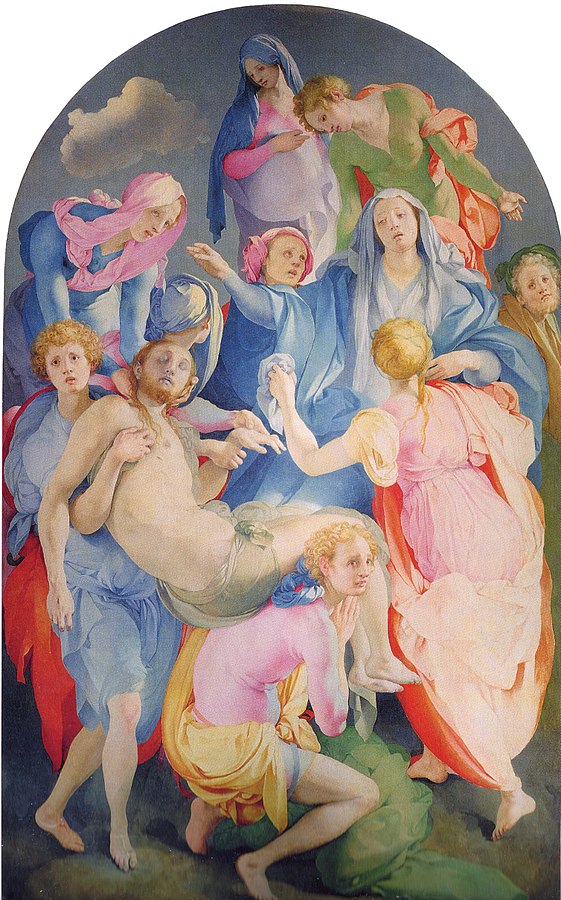
Jacopo da Pontormo, Entombment of Christ.
Capponi chapel, Santa Felicità, Florence, Italy, 1525–1528.
Oil on wood.
An example of Mannerism, this painting belies any traditional elements of similar paintings (excluding a cross or tomb), impossible physical contortions of human forms, and non-specific composition with no background and negative space between the figures, accentuated by bright contrasting colors.

Benvenuto Cellini, Saltcellar of Francis I.
1540–1543.
Gold, enamel, and ebony.
Commission by Francis I. Mannerist sculpture; the figures have elongated proportions, particularly the female form of Tellus is represented in contrast with traditional matronly depictions.

Andrea Palladio, Villa Rotonda.
Near Vicenza, Italy, ca. 1550–1570.
Late Renaissance architectural villa, central plan with four-way symmetry evoking classical temples hybridized with contemporary elements.
Cimabue
Late Medieval Painter
One of the first painters to depart from the Italo-Byzantine style increasing three-dimensionality and depth in paintings.
Works ca. 1280–1290 in Florence, Italy.
Madonna Enthroned with Angels and Prophets
Giotto
Late Medieval Painter
Paintings with increased humanism and naturalism in distinct departure from Gothic styles prior to the start of the 14th century.
Works ca. 1305–1306 in Padua, Italy.
Interior of the Arena Chapel (Cappella Scrovegni)
Duccio
Late Medieval Painter
Further departs from Italo-Byzantine style as begun by Cimabue, with further increased treatment of depth with more humanistic depictions of holy figures.
Works ca. 1308–1311 in Siena, Italy.
Virgin and Child Enthroned with Saints, principal panel of the Maestà altarpiece
Simone Martini and Lippo Memmi
Late Medieval Painters
Another painter(s) continuing the trend of departure from the Italo-Byzantine style, now with inclusion of splendiferous and dramatic styling appealing to growing aristocratic tastes.
Works ca. 1333 in Siena, Italy.
Annunciation, from the altar of Saint Ansanus
Ambrogio Lorenzetti
Late Medieval Painter
Pushed realism in art in the early 14th century, notably through allegorical paintings including landscapes and cityscapes populated by figures.
Works ca. 1338–1339 in Siena, Italy.
Allegory of Good Government
Claus Sluter
Late Medieval Sculptor
Enhanced sculptural depictions of human forms with increased naturalism/humanism. Sculptures depict emotion and pose better and look more like figures than structure.
Works ca. 1396–1406 in Dijon, France.
Well of Moses
Limbourg brothers (Pol, Herman, Jean)
Late Medieval Illustrators
Introduced contemporary illusionistic techniques into illumination and illustration in books.
Works ca. 1413–1416 in Duchy of Berry, France.
January, from Les Très Riches Heures du Duc de
Berry
Hubert and Jan van Eyck
Late Medieval Painters
Court painter to Philip the Good, duke of Burgundy. Famous for incredible attention to minute detail in rendering realistic scenes.
Works ca. 1435–1442 in Ghent, Belgium.
Ghent Altarpiece
Rogier van der Weyden
Late Medieval Painter
This artist’s works include great care and attention placed on the figures expressions, working to depict strongly humanized biblical characters expressing believable emotions.
Works ca. 1435–1442 in Louvain, Belgium.
Deposition, center panel of a triptych from Notre-Dame hors-les-murs
Petrus Christus
Late Medieval Painter
Works include a notable focus on detail in ordinary objects, particularly in the vocational work listed below. Example of the increasing role of guilds as patrons of the arts.
Works ca. 1449 in Northern Europe.
A Goldsmith in His Shop
Michael Wolgemut and workshop
Late Medieval Printmaker
With the invention of printing in Europe, printmaker became a new artistic career, kicked off by this artist and his workshop.
Works ca. 1493 in Northern Europe.
Madeburga, page from the Nuremberg Chronicle
Lorenzo Ghiberti
Early Renaissance Sculptor
Talented sculptor and goldsmith, beat Brunelleschi to win the commission for the new quatrefoils for the Florence baptistry doors with naturalist and dramatic humanist style. Worked on castings for doors to this structure for the rest of his career.
Works ca. 1425–1452 in Florence, Italy.
East doors (Gates of Paradise) of the Baptistery of San Giovanni
Nanni di Banco
Early Renaissance Sculptor
Developments in depiction of natural and humanistic forms in sculpture, able to imitate conversation and emotion through stone, while drawing influence from classical sculpture.
Works ca. 1410–1414 in Florence, Italy.
Four Crowned Saints
Donatello
Early Renaissance Sculptor
Very prolific sculptor, notable for precise and anatomical forms in sculpture and from drawing from classical trends such as the heroic male nude and controposto posing.
Works ca. 1411–1460 in Florence, Italy.
Saint Mark
David
Masaccio
Early Renaissance Painter
First painter to use system of linear perspective to create realism in paintings.
Works ca. 1424–1427 in Florence, Italy.
Tribute Money
Holy Trinity
Filippo Brunelleschi
Early Renaissance Architect
After losing a major commission to Ghiberti, studied architecture in Rome, then codified mathematical system of linear perspective for use as an illusionistic device. Responsible for several technical innovations in architecture to construct the Florence dome (see below).
Works ca. 1420–1436 in Florence, Italy.
Dome of the Cathedral of Santa Maria del Fiore
Michelozzo di Bartolommeo
Early Renaissance Architect
Architect following in the revival of classical ratios and sensibilities in developing Renaissance architecture, but also responsible for unique style for outer facade of Medici palace with 3-tiered structure that set trends in future architecture.
Works ca. 1445 in Florence, Italy.
Palazzo Medici-Riccardi
Piero della Francesca
Early Renaissance Painter
Combined features of classical portraiture (namely profile views of government leaders typical of coinage) with naturalistic landscapes.
Works ca. 1472–1474 in Urbino, Italy.
Battista Sforza and Federico da Montefeltro
Leon Battista Alberti
Early Renaissance Architect
Draws strong inspiration from classical temple and victory arch structures, hybridizing them into a unique Renaissance style.
Works ca. 1472 in Mantua, Italy.
West facade of Sant’Andrea
Andrea Mantegna
Early Renaissance Painter
Artist with strong skills in naturalistic and humanistic depictions, to the extent of creating virtual spaces extending rooms with illusionistic elements to deceive the eye.
Works ca. 1465–1474 in Mantua, Italy.
Interior of the Camera Picta (Painted Chamber), Palazzo Ducale
Sandro Botticelli
Early Renaissance Painter
Revival of classical mythological subject matter and the female nude, painted for private display for wealthy patrons. Art deviates from contemporary developments in naturalism and human form in favor of more stylistic, fluid and weightless design.
Works ca. 1484–1486 in Florence, Italy.
Birth of Venus
Leonardo da Vinci
High Renaissance Painter
The Renaissance man himself. His paintings are notable for strong compositional forms, masterful smooth shading with light and dark, and mysterious, dramatic depictions leveraging humanistic and illusionistic tools.
Works ca. 1483–1498 in Milan, Italy.
Madonna of the Rocks
Last Supper
Raphael
High Renaissance Painter
Drawing inspiration from Leonardo in terms of composition and color technique, his paintings are distinctly brighter with strong symbology, attractive to Julius II.
Works ca. 1509–1511 in Vatican City, Rome, Italy.
Philosophy (School of Athens)
Michelangelo Buonarroti
High Renaissance Sculptor and Painter
Masterful sculptor with devotion to depicting the human form with power and grandeur. His skills and eye for form in sculpture translate to his painting style.
Works ca. 1501–1541 in Florence and Vatican City, Rome, Italy.
David
Sistine Chapel ceiling
Last Judgement
Donato d’Angelo Bramante
High Renaissance Architect
Further drawing classical inspiration into Renaissance architecture, combines classical features in unique ways with Renaissance styling, and brings central plan architecture back into vogue.
Works ca. 1502 in Rome, Italy.
Tempietto
Giovanni Bellini
High Renaissance Painter
Notable for excellent treatment of color and illusionistic perspective, luxurious scenes fitting with Venetian culture.
Works ca. 1505 in Venice, Italy.
Madonna and Child with Saints (San Zaccaria Altarpiece)
Giorgione da Castelfranco
High Renaissance Painter
A highly mysterious figure with just as mysterious paintings. Developed painting as a form of poetic expression beyond depiction of existing narrative scenes and reality.
Works ca. 1509–1510 in Venice, Italy.
The Tempest
Titian
High Renaissance Painter
Drawing influence in colorful composition and some mysterious aspects from contemporary Venetian painters, this artist makes powerful use of color, composition, and expressive human forms to depict subjects in a uniquely powerful and emotional manner.
Works ca. 1519–1538 in Venice and Urbino, Italy.
Pesaro Madonna
Venus of Urbino
Lavinia Fontana
High Renaissance Painter
Notable for being one of few female Renaissance artists, with the largest surviving collection of works.
Works ca. 1580.
Portrait of a Noblewoman
Jacopo da Pontormo
Mannerist Painter
Characterizing early Mannerist developments, paintings have unique style deviating from rational laws of contemporary Renaissance works with focus instead to depict the scene in stylish and dramatic grace.
Works ca. 1525–1528 in Florence, Italy.
Entombment of Christ
Benvenuto Cellini
Mannerist Sculptor
Bringing Mannerism to sculpture, his works include unique stylization and dynamicism.
Works ca. 1540–1543.
Saltcellar of Francis I
Andrea Palladio
Late Renaissance Architect
Continues bringing classical architectural elements into Renaissance architecture, with central plans and rational structure and symmetry. He developed architectural systems for multi-building compounds suitable for farms and plantations.
Works ca. 1550–1570 in Vicenza, Italy.
Villa Rotonda
Iconography
Refers to both the content (subject matter) of a work of art and the study of the content in art, understanding the specific culturally constructed symbols and motifs in a work of art
Patron
Person or entity who pays artists to make specific works, or employs them on a continuing basis
Gothic
Term to describe western European art and architecture ca. 12th-15th centuries
Classical
Art of ancient Greece and Rome
Maniera greca
Italo-Byzantine style, characterized by prevalence of gold leaf and symbolic representations of figures
Byzantine Empire (East Roman Empire)
Greek-speaking Roman state that existed from ca. 330 until conquered by Ottoman Turks in 1453 CE
Stigmata
Marks resembling Christ’s wounds, found on Saint Francis’s hands and feet
Mendicant
“Begging” - orders of monks dependent on charity to support their work
Franciscans
Mendicant order of monks with mmphasis on brotherhood, humility, chastity, repentance
Saint Francis of Assisi
Founder of Franciscan Brotherhood, lived 1181-1226
Dominicans
Mendicant order of monks with emphasis on learning, preaching, combating heresy
Saint Dominic de Guzman
Founder of Dominican Brotherhood, lived 1170-1221
Baptistery
Building where baptisms are performed in a cathedral complex, traditionally an octagonal structure
Pulpit
Elevated platform used in preaching or conducting a religious service
Relief sculpture
Form of sculpture in which the ornaments or figures are attached to a background, from which they stand out to a greater or lesser degree
Tempera
Paint medium consisting of blended egg yolk and pigment, popular in the late Medieval period and declining through early and high Renaissance times.
Cathedral
Central church in a bishop’s diocese (administrative district)
Fresco
Painting technique in which water-based wet paint is applied to a wet plaster surface (buon fresco)
Enrico Scrovengi
Member of a banking family in Padua, Italy ca. 1305-1306. Commissioned the Arena Chapel (Cappella Scrovengi) from Giotto di Bondone as atonement for financial sins.
Foreshortening
A technique for creating the illusion of depth in a two-dimensional picture by distorting figures and objects so they appear to recede or project sharply into space.
Perspective
General term meaning illusionistic rendering of three-dimensional world on a two-dimensional surface.
Grisaille
Monochrome drawing or painting in shades of gray, sometimes in imitation of sculpture.
Predella
Base of an altarpiece
Palazzo pubblico
“Public palace” - town hall, specifically in Siena
Black Death
First spread 1347-1352, killing 1/3 to 1/2 of the population of western Europe.
Flanders
Region in north of modern France, under control of Dukes of Burgundy until 1477
King John II
(Jean le Bon) King of France r. 1350-1364
Philip the Bold
(Philippe le Hardi) Duke of Burgundy r. 1363-1404, prolific Patron in Northern Europe in the 14th century late Medieval period. Founded the Chartreuse (“Charter house”) de Champmol, a Carthusian monastery near Dijon.